|
Meinem Lehrer und Freund Prof. Dr. Heinrich von Stietencron ist die gesamte Amarakośa-Übersetzung in Dankbarkeit gewidmet. |
Zitierweise | cite as: Amarasiṃha <6./8. Jhdt. n. Chr.>: Nāmaliṅgānuśāsana (Amarakośa) / übersetzt von Alois Payer <1944 - >. -- 2. Dvitīyaṃ kāṇḍam. -- 14. kṣatriyavargaḥ (Über Kṣatriyas). -- 2. Zweiter Abschnitt (Über Kriegsführung). --3. Vers 19 - 26 (Wagen). -- Fassung vom 2011-06-07. -- URL: http://www.payer.de/amarakosa6/amara2142c.htm
Erstmals hier publiziert: 2011-06-07
Überarbeitungen: 2011-06-30 [Ergänzungen]
©opyright: Creative Commons Lizenz (Namensnennung, keine kommerzielle Nutzung, share alike)
Dieser Text ist Teil der Abteilung Sanskrit von Tüpfli's Global Village Library
|
Meinem Lehrer und Freund Prof. Dr. Heinrich von Stietencron ist die gesamte Amarakośa-Übersetzung in Dankbarkeit gewidmet. |
Falls Sie die diakritischen Zeichen nicht dargestellt bekommen, installieren Sie eine Schrift mit Diakritika wie z.B. Tahoma.
Die Devanāgarī-Zeichen sind in Unicode kodiert. Sie benötigen also eine Unicode-Devanāgarī-Schrift.
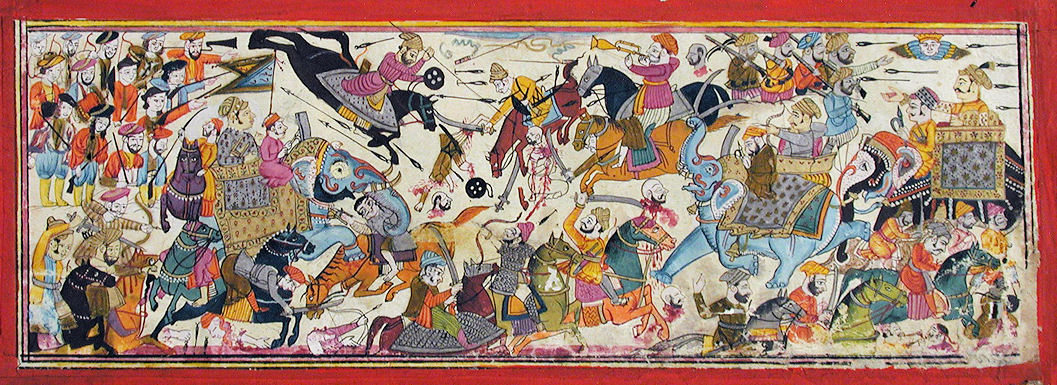
Abb.: Kampfszene, Bhāgavata-Purāṇa-Handschrift, Uttar Pradesh,
ca. 1780
[Bildquelle: Asian Curator at The San Diego Museum of Art. --
http://www.flickr.com/photos/asianartsandiego/4838434662/. -- Zugriff am
2011-04-10. --
Creative Commons Lizenz (Namensnennung, keine kommerzielle Nutzung,
keine Bearbeitung)]
|
19a./b. yāne cakriṇi yuddhārthe śatāṅgaḥ
syandano rathaḥ याने चक्रिणि युद्धार्थे शताङ्गः स्यन्दनो रथः ।१९ क। Bezeichnungen für ein Räderfahrzeug für Kriegszwecke:
|
Colebrooke (1807): "A war chariot."
Siehe auch Vers 27c-28 ; 44a/b.
शताङ्ग - śatāṅga m.: "Hundertgliedriger", Reisewagen, Wagen
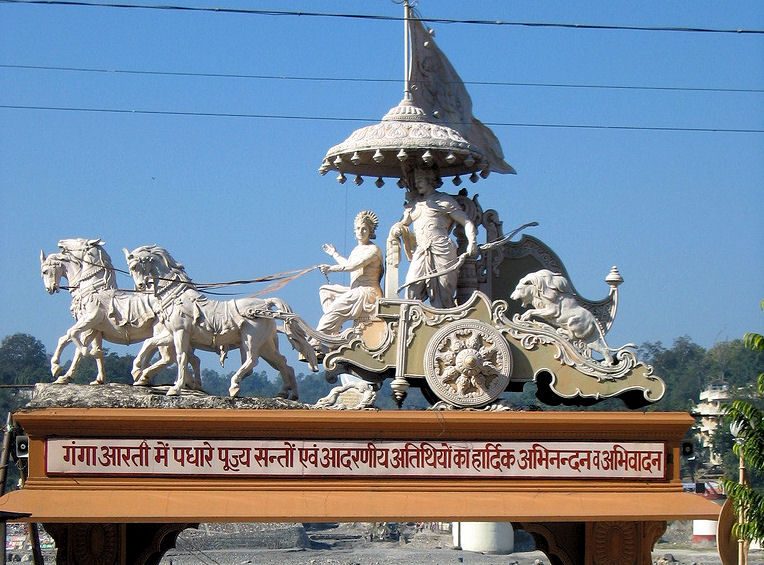
Abb.: शताङ्गः । Kṛṣṇa und Arjuna, Rishikesh -
ऋषिकेश, Uttarakhand
[Bildquelle: Ajay Tallam. --
http://www.flickr.com/photos/90417577@N00/2376049642/. -- Zugriff am
2011-06-05. --
Creative
Commons Lizenz (Namensnennung, share alike)]
स्यन्दन - syandana m.: "Eiler", Fahrzeug, Wagen
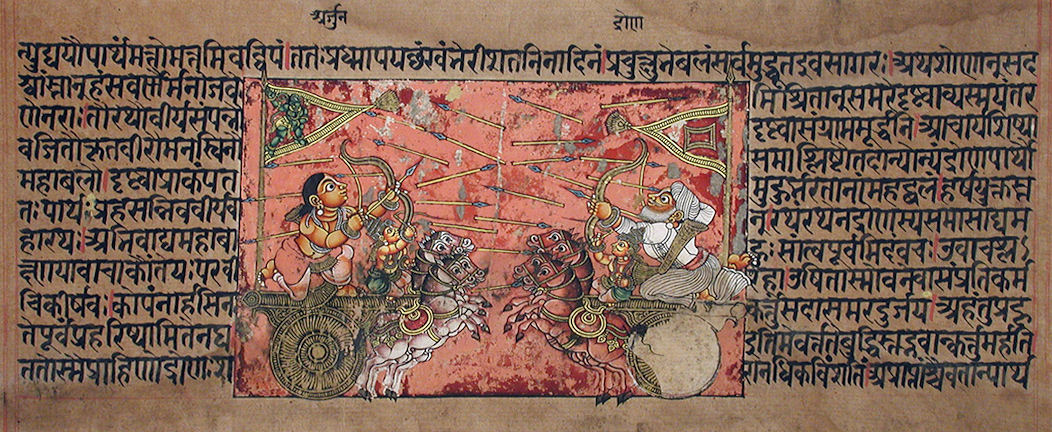
Abb.: स्यन्दनौ । Kampf zwischen Arjuna und Droṇa, Karnataka, 1670
[Bildquelle: Asian Curator at The San Diego Museum of Art. --
http://www.flickr.com/photos/asianartsandiego/4838540124/. -- Zugriff am
2011-04-12. --
Creative Commons Lizenz (Namensnennung, keine kommerzielle Nutzung,
keine Bearbeitung)]
रथ - ratha m.: Streitwagen, Wagen
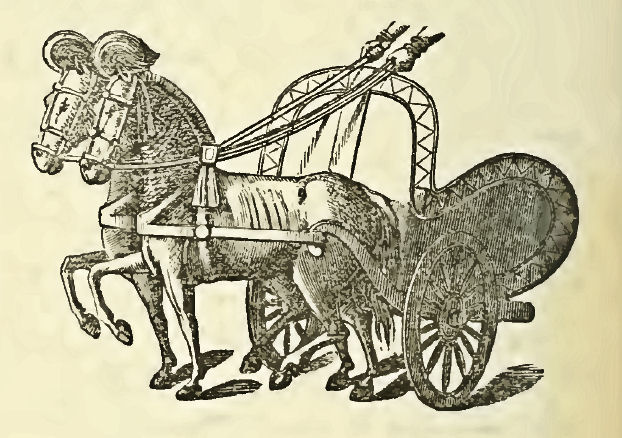
Abb.: रथः । Streitwagen
[Bildquelle: Mitra, Rājendralāla <1824-1891>: Indo-Aryans:
contributions towards the elucidation of their ancient and mediaeval history.
-- London : Stanford, 1881. -- 2 Bde. : Ill. ; 23 cm. --
Bd. 1, S. 340]
Dreiunddreißigstes Kapitel (49. bis 51. Gegenstand). Der Wagenaufseher, der Fußsoldatenaufseher und der Feldmarschall.
Was auf den Pferdeaufseher, das ist auch auf den Wagenaufseher anwendbar.
Er soll die Arbeiten, die sich auf die Wagen beziehen, verrichten lassen.
Der Wagen (ratha) ist für zehn Mann, mit Gelegenheit für zwölf. Von da ab je um die Gelegenheit für einen vermindert, herab bis zu Gelegenheit für sechs, ergibt sieben Wagenarten.1
Er soll Götterwagen, Staatswagen,2 Streitwagen, Reisewagen, Wagen, die feindlichen Bargen anzugreifen, und Wagen zum Einüben machen lassen.
Er soll sich verstehen auf die Ausrüstung (der Wagen) mit Bogen, Angriffswaffen, Schutzwaffen und allem Zubehör, ebenso darauf, wie Wagenlenker, Wagenkämpfer und Wagenpferde zu ihren einzelnen Betätigungen richtig verwendet werden.3 Bis in die einzelnen Verrichtungen hinein soll er Nahrung und Lohn kennen und bei den fest Angestellten und den nicht fest Angestellten (den Arbeitern) die Aufrechterhaltung angemessenen Schutzes (gegen böse Einflüsse) und das Geschäft des Beschenkens und Beehrens.
Fußnoten
1 Sham.'s und Gaṇ.'s wohl auf Bhaṭṭ. zurückgehende Anschauung dieser Stelle ist unmöglich. Sogar wenn man, was hier doch wunderlich wäre, den »Schattenmann« von 12 aṅgula Länge zum Maß nehmen will, kommt ein Wagenungetüm von 71/2 Fuß Höhe und 9 Fuß Weite heraus. Greifen wir dagegen zum Flächenmaß, dann erhalten wir ein Kinderwägelchen. Sodann: Wenn das Maß gemeint wäre, müsste doch pauruṣa, nicht puruṣa gebraucht sein. Aber auch Steins Wagen mit 12 Abteilungen ergibt ein Unding. Siehe Meg. und Kauṭ. 275 f. Antara hat hier seine bei Kauṭ. ganz gewöhnliche Bedeutung, wie puruṣa seinen alltäglichen Sinn. Es heißt: Innenraum, Fassungsraum und damit Möglichkeit, Gelegenheit. Der als Norm geltende, d.h. der größte regelrechte Wagen ist also für Mann berechnet, kann aber im Notfall auch 12 halten. Der nächste an Größe deren 11, und so herab bis Nr. 7, der für vier Mann gebaut ist, aber wenn es sein muß, auch sechsen Fassungsraum oder Fahrgelegenheit bietet. Dieser letzte stimmt nicht schlecht zu der Angabe des Megasthenes, daß ein Wagenlenker und zwei Kämpfer im Kriegswagen gestanden hätten. Im Kampfe hat der einzelne Mann mehr Raum nötig als sonst. Sodann müssen ja auch Waffen untergebracht werden, öfters wohl auch ein Diener. Größer sind auch die Kriegswagen des Epos nicht.A1
2 Puṣyaratha (Pāli phussaratha) bedeutet, wie ich schon Hindu Tales S. 131, Anm. 3 angegeben habe, »Staatswagen« (nicht »Vergnügungswagen«, wie die Wörterbücher sagen). Bhaṭṭ. zu unserer Kauṭilyastelle bestätigt meine Anschauung, denn er sagt, es sei ein Wagen, der bei Krönungen usw. bestiegen werde. Wie prächtig solch ein Staatswagen ist und das Gespann davor, schildert Uvāsagadasāo § 206.
3 Āyoga hier und anderwärts bei Kauṭ.: die richtige Verwendung oder Anstellung, und damit in gewissen Verbindungen auch fitness und unfitness (Sham.) (Brauchbarkeit und Unbrauchbarkeit).
A1 Dieser spielt da natürlich eine sehr große Rolle. Über seine verschiedenen Teile und seinen Bau gibt besonders MBh. VII, 202, 71ff.; VIII, 16, 13–15; 19, 10–12; 34, 16ff. Auskunft. Eingehend hat Hopkins, Ruling Caste auch über die Kriegswagen geredet, ist mir aber nicht zur Hand. Könige haben krīḍāratha Wagen zu Lustfahrten und sāṃgrāmika ratha oder Streitwagen. MBh. XIII, 53, 27–33. Auch vor die Reisewagen werden vier Pferde gespannt. MBh. III, 71, 19. Mit Elefanten bespannte Wagen finden wir ebenfalls im MBh. So in II, 52, 29; K. 78, 26f.; K XIV, 100, 91f.; 103, 73. Vom rathapa oder Wagenaufseher und den Erfordernissen für ihn redet auch Śukran. II, 264ff."
[Quelle: Kauṭilya: Das altindische Buch vom Welt- und Staatsleben : das Arthaśāstra des Kauṭilya / [aus dem Sanskrit übersetzt und mit Einleitung und Anmerkungen versehen von] Johann Jakob Meyer [1870-1939]. -- Leipzig, 1926. -- Digitale Ausgabe in: Asiatische Philosophie. -- 1 CD-ROM. -- Berlin: Directmedia, 2003. -- (Digitale Bibliothek ; 94). -- S. 223f.]
"From references in the Mahābhārata it appears that chariots had only two wheels. Vide Bhīṣma 98. 47, Droṇaparva 154. 3, Śalya 16. 24 (Śaineyo dakṣiṇaṃ cakraṃ Dhṛṣṭadyumnas tathottaram),.Two noted warriors were told off to guard the two wheels of the chariot of the principal commanders and are called 'cakra-rakṣau ' ( vide Bhīṣma 54. 76, 108. 5, Droṇa 91, 36, Karṇa 11. 31, 34. 44 ). Chariots of great warriors were drawn by four horses e. g. Ādi. 198. 15, Udyoga 48. 50, Drona 145. 81. Udyoga 83. 15-21 describe the chariot of Kṛṣṇa and Udyoga,140. 21 states that chariots had small tinkling bells attached to them and also screens of tiger-skin. The Ṛg. contains very graphic descriptions of chariots. Chariots were generally drawn by two horses in the vedic age (Ṛg. V. 30.1, V. 36.5, VI. 23. 1) and had two wheels, but the chariot of the Aśvins is described as having three wheels (Ṛg. I. 118. 2, I 157. 3, X. 41. 1). Ghaṭotkaca, however, had eight wheels to his chariot (Droṇa 156. 61, 175. 13 ). " "In medieval times chariots appear to have become obsolete. In the graphic descriptions of armies contained in the Harsacarita (particularly in the 7th ucchvāsa) war chariots are conspicuous by their absence."
[Quelle: Kane, Pandurang Vaman <1880 - 1972>: History of Dharmaśāstra : (ancient and mediaeval, religious and civil law). -- Poona : Bhandarkar Oriental Research Institute. -- Vol. IV. -- 2. ed. -- 1973. -- S. 205f.]
"The chariot.—The earliest chariot was a ear of two or three wheels, and with one, two, or three horses; in the Epic we find the same, or one of four, sometimes eight, wheels; and with two, three, or four horses, or (in the latest portions) eight.
In particulars, we find the Vedic war-car, ratha, placed on a box, kośa, fixed on a wooden axle, akṣa, fastened by cowhide thongs. The seat, bandhura, is single; in the case of gods, three to eight seats, as fancy dictates, are mentioned. The knight stands on the floor of the car, garta, to the left of his driver. A rim is perhaps to be assumed as protecting the car, called aṅka, perhaps comparable etymologically with
αντυξ. The wheel-spokes are of wood. A banner-pole stands erect in the car. A horse stands on each side of the pole, and the two are yoked, guided by a bit, śiprā, and reins, while urged by a goad (or whip). Only Indra has a caturyuga, τετρωρον αρμα. One horse in shafts was a sign of poverty. The car and pole were decorated. Axe and bow were the chief weapons, but knives and others smaller are used. Many warriors fight on foot; also 'riders' are mentioned, but not regular cavalry. This is all we know with certainty of the Hindu chariot before the Epic.Three drivers might stand on the broad shelf that ran in front of the largest Epic war-car (ratha, rarely yāna, wagon). In the rear stood the knight. To shoot directly in front he leaned over a fence-rim between the belly of the car and the horses, of which in this case four were used ; or mules instead were employed. Each chariot is stocked with arms, and many more are borne behind by attendants. Over each war-car stood an emblem-pole, and shone silk-emblazoned banners with woven or painted figures of allegorical import. A covering over the largest war-cars protected from the direct rays of the sun, a covering used as well on the field as on a march (ātapatra: xv. 23.8).
Over against this view of the large four-horse chariot, we have the simpler picture of a two-horse car, small in size, containing only the knight and one attendant, the charioteer. This car was much smaller, and, indeed, Homeric; for, as in the Iliad one man seeks to pick up and run away with a chariot, so we find here a knight attempting to lift a war-car alone out of a morass. Outside of the war proper we find the chariot-duel. Of course impromptu meetings of two chariots and the subsequent strife between the occupants are of frequent occurrence in the battle scenes ; but it is significant that, apart from the field of actual battle, a king proposes in one of the early books to recover his kingdom by instituting 'a duel in chariots' between his adversary and himself, the result of which shall establish peace.
The number of charioteers depends on the horses. When two horses are sufficient, one sārathi or charioteer is sufficient also. In the case of four horses (two fastened to the pole, two by straps outside, not tandem: dhur and pārṣṇi), we nave one charioteer in the middle, who guides the pole-horses, and on each side of him the two drivers of the outer steeds, pārṣṇiṣā-rathī. In proverbs and verses of late origin it is universally assumed that four horses will be used. Thus (vii. 112.46 ff.): 'Let the rathakalpakāḥ according to rule arrange the chariot,' which has five qualities, and four horses; and we are expressly told in the opening description that all the knights had four-horse chariots. But that such was not always the ease will be seen below from the account of the poem itself.
I now examine in detail the war-car and the steeds.
The parts of the chariot (ratha, yāna, syandana = currus): Beneath is the axle (akṣa), to the ends of which the wheels are attached, and above and before which is the charioteer's place, while above and behind is the place of the knight. The 'nest' or box above is so intimately connected with the axle that the two are often broken together. The noiseless running of the axle is especially praised. The mention of this part of the wagon often implies that the car has only two wheels—as where, in enumerating disasters following single arrows, we find that a knight broke the single yoke with one arrow; the 'threefold-piece,' with three; the four steeds, with four; and the one axle (the two wheels), with two (iv. 57.36). In iii. 134. 9 this is formally stated to be the case. The wheel consists, besides the wooden circle, of the tire (rathanemi, vi. 117.54), the spokes (ara), and the hub (nābhi). The ' place at the spokes' (arāsthāna) was reserved for knights, high-born attendants of the king, 'who at the master's chariot did mighty deeds in the van.' The tire, which was also called 'fore-circle' (pra-maṇḍala), appears to be of iron, if we may judge from constant reference to the 'noise of the hoofs and the tires.' But what is the 'chariot-nest' ? and does it differ from the 'chariot-lap' ? Between these two expressions (rathanīḍa, rathopastha) I think we may discern a distinction. The upastha was the general bottom of the car; the nīḍa was the little shelf in front where the charioteer stood. This difference existed probably in four- horse chariots only.
[...]
Some parts of the chariot are not easily explained, as they are rarely mentioned, and not described. Thus, we find in a list of parts of chariots, besides those already discussed, the daṇḍaka, apparently equivalent to yaṣṭi, the banner-staff; the jaṅghā, probably the akṣajaṅghā or ' axle-tree;' and the daśana, perhaps the spokes (unless the harness in general be meant). The triangle-piece, elsewhere explained, is said in another passage of this book to be silvered; and from the same paragraph we may add a new item to the car, namely the tri-kośa or threefold receptacle, said to be of gold, i. e. gilded : 'the war-car decked with tiger-skins, of noiseless axle, golden tri-kośa, and silver triangle-piece.' Kośa alone is specifically a sheath for a sword. We may have in the last three epithets three near parts, axle, axle-box, axle-pole-triangle, as kośa is used in Vedic literature; but why three-fold ? On account of its non-specific meaning, frequent in the Epic, I prefer to regard it as indication of three compartments for receiving arms."
[Quelle: Hopkins, Edward W. (Washburn) <1857 - 1932>: The social and military position of the ruling caste in ancient India; as represented by the Sanskrit epic; with an appendix on the status of woman. -- Reprint from the 13th volume of the Journal of the American Oriental Society (1888). -- New Haven, Conn. : Tuttle, 1889. -- S. 235 - 238, 249]
|
19c./d. asau puṣparathaś cakrayānaṃ na samarāya
yat असौ पुष्परथश् चक्रयानं न समराय यत् ॥१९ ख॥ Ein Radfahrzeug, das nicht dem Kampf dient, heißt पुपरथ - puṣparatha m.: "Blumenwagen", Wagen für Vergnügungsreisen, Wagen für zivile Zwecke |
Colebrooke (1807): "Any other car. For travelling, &c."
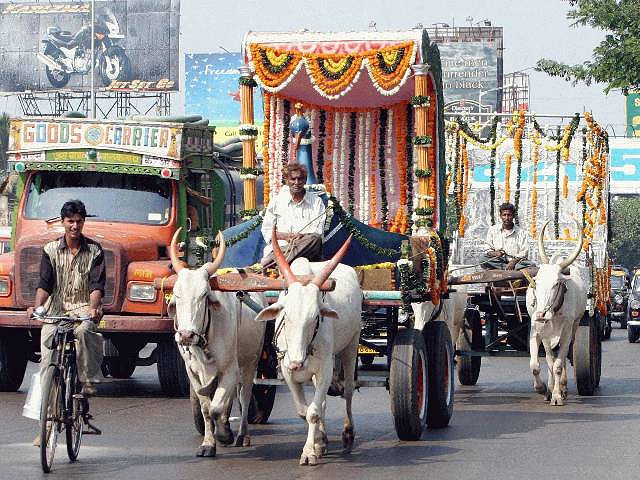
Abb.:

Abb.: पुष्परथः । Wagen, Amaravati - అమరావతి,
Andhra Pradesh
[Bildquelle: Mitra, Rājendralāla <1824-1891>: Indo-Aryans:
contributions towards the elucidation of their ancient and mediaeval history.
-- London : Stanford, 1881. -- 2 Bde. : Ill. ; 23 cm. --
Bd. 1, S. 352]
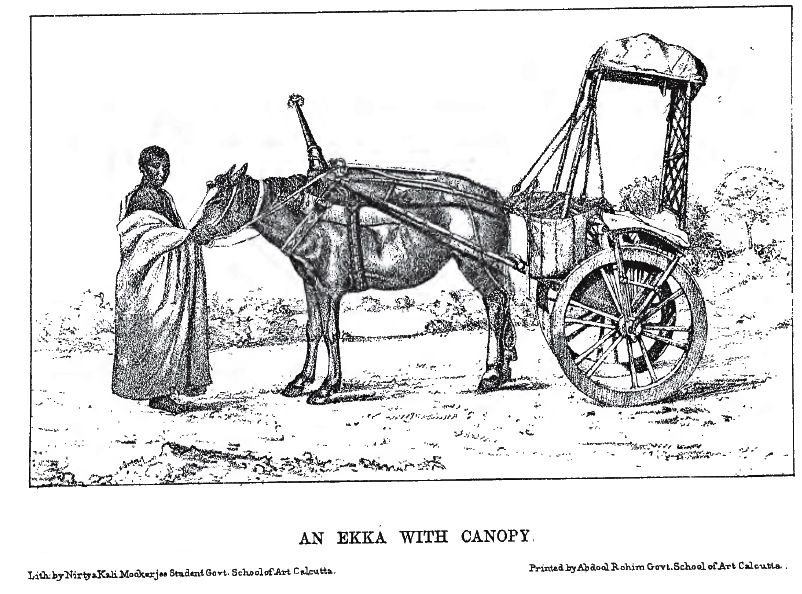
Abb.:
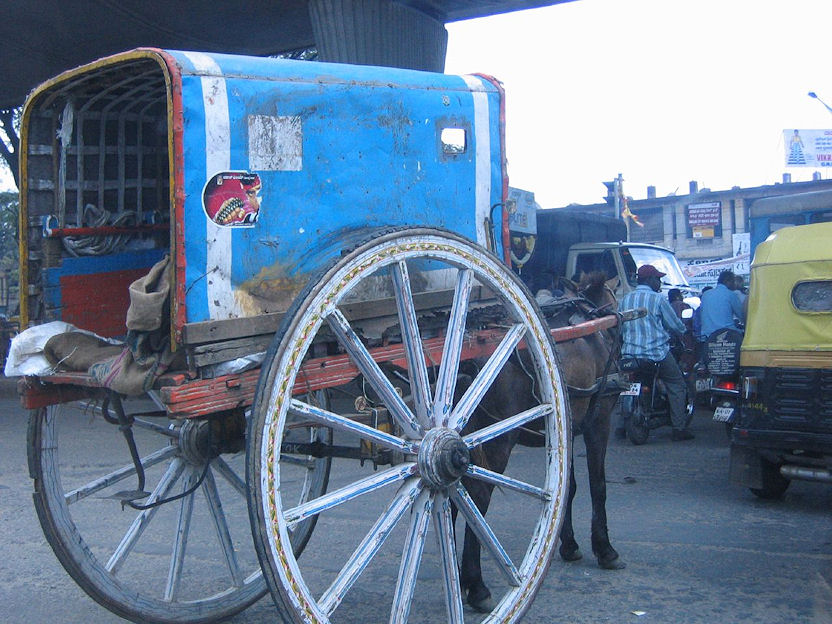
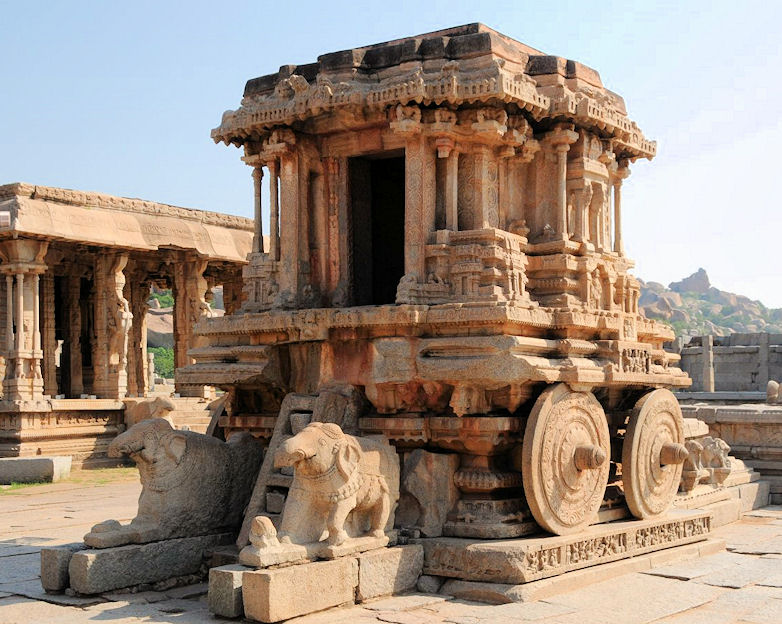
Abb.:
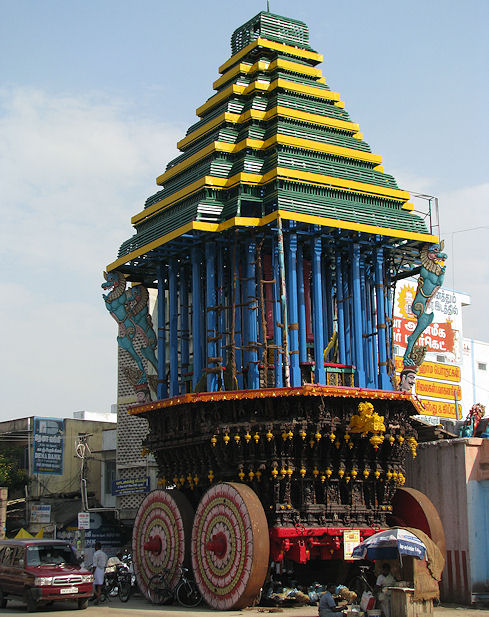
Abb.:
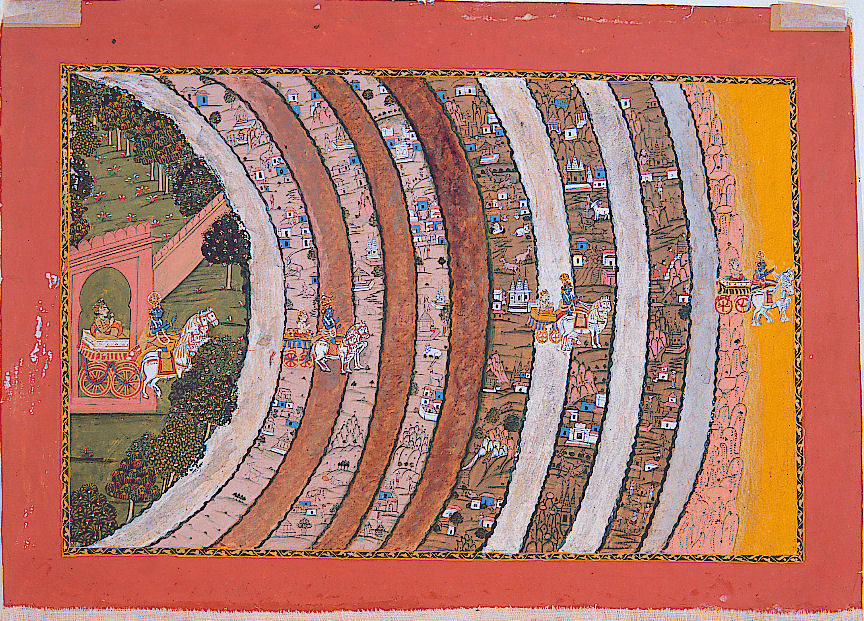
Abb.:
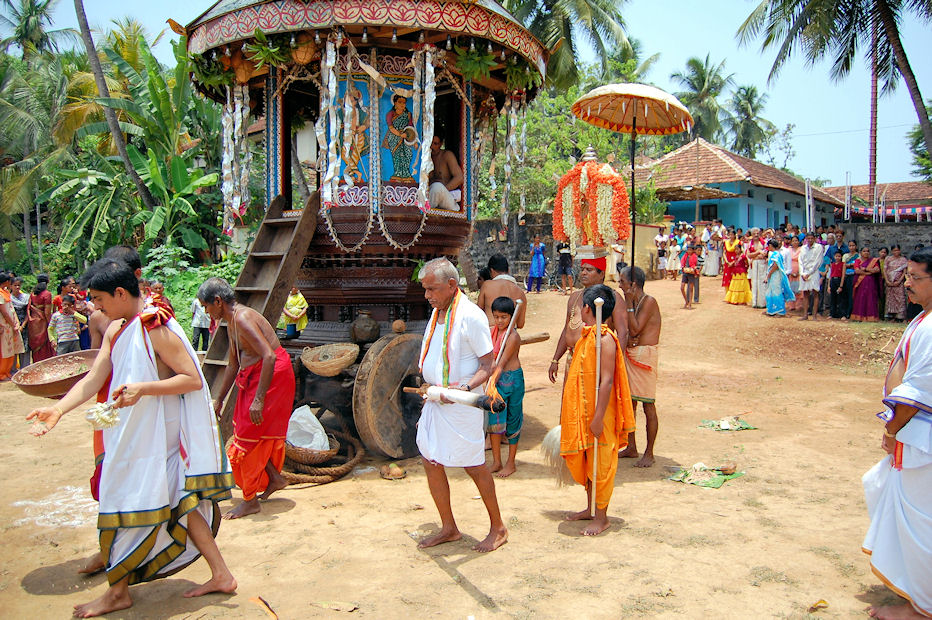
Abb.:
| 20a./b. karṇīrathaḥ pravahaṇaṃ
hayanaṃ ca samaṃ trayam कर्णीरथः प्रवहणं हयनं च सम त्रयम् ।२० क।
|
Colebrooke (1807): "A covered car. For the conveyance of women ; but some interpret this a small covered car for diversion ; or else a litter to be borne on men's shoulders."
| 20c./d. klībe 'naḥ śakaṭo 'strī
syād gantrī kambalivāhyakam क्लीबे ऽनः शकटो ऽस्त्री स्याद् गन्त्री कम्बलिवाह्यकम् ॥२० ख॥Bezeichnungen für Karren:
|
Colebrooke (1807): "A cart."
अनस् - anas n.: Lastwagen, Karren
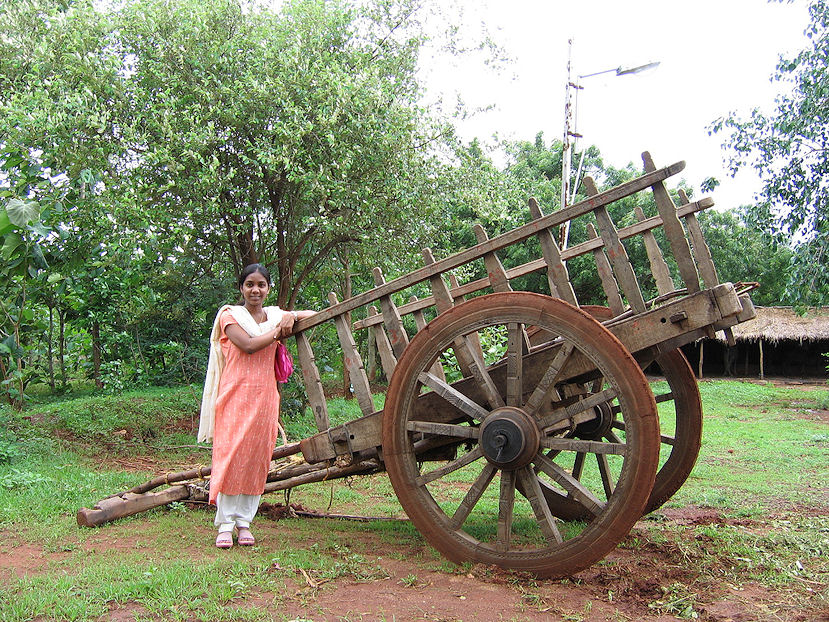
Abb.: अनः । Zahirabad - జహీరాబాద్, Andhra Pradesh
[Bildquelle: Prato. --
http://www.flickr.com/photos/71279724@N00/150131779/. -- Zugriff am
2011-06-05. --
Creative Commons Lizenz (Namensnennung, keine kommerzielle Nutzung,
keine Bearbeitung)]
शकट - śakaṭa m., n.: Karren, Wagen
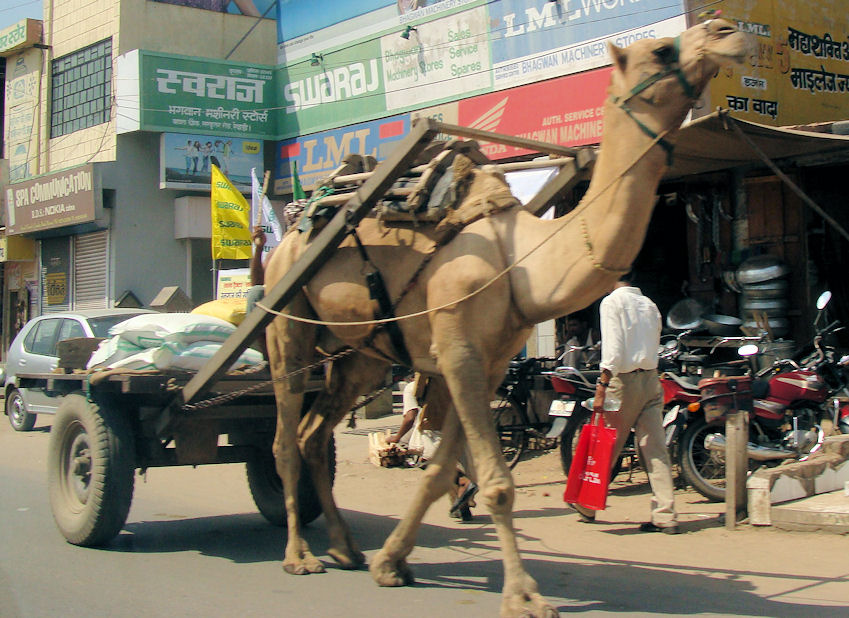
Abb.: शकटः । Bikaner - बीकानेर, Rajasthan
[Bildquelle: Clara & James. --
http://www.flickr.com/photos/clara/2103145612/. -- Zugriff am
2011-06-05. --
Creative
Commons Lizenz (Namensnennung, keine kommerzielle Nutzung, share alike)]
| 20c./d. klībe 'naḥ śakaṭo 'strī syād
gantrī kambalivāhyakam क्लीबे ऽनः शकटो ऽस्त्री स्याद् गन्त्री कम्बलिवाह्यकम् ॥२० ख॥[Bezeichnungen für Ochsenkarren:]
|
Colebrooke (1807): "A carriage drawn by oxen."
गन्त्री - gantrī f.: "Läuferin", Ochsenkarren
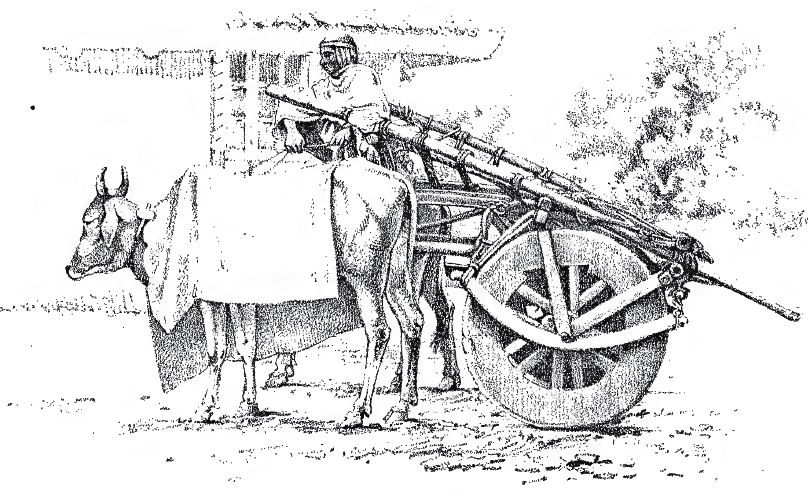
Abb.: गन्त्री । Wagen
(cakra) Bihār, 19. Jhdt.
[Bildquelle: Grierson, George Abraham <1851-1941>: Bihār
peasant life : being a discursive catalogue of the surroundings of the
people of that province. -- Calcutta : Bengal Secretariat Press, 1885. --
Vor S. 25.]
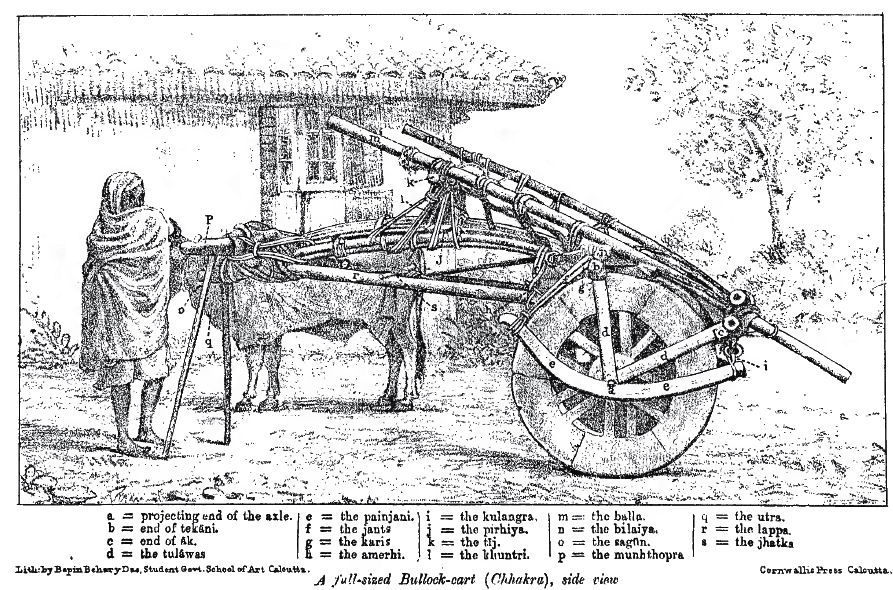
Abb.: गन्त्री । Wagen
(cakra) Bihār, 19. Jhdt.
[Bildquelle: Grierson, George Abraham <1851-1941>: Bihār
peasant life : being a discursive catalogue of the surroundings of the
people of that province. -- Calcutta : Bengal Secretariat Press, 1885. --
Vor S. 29.]
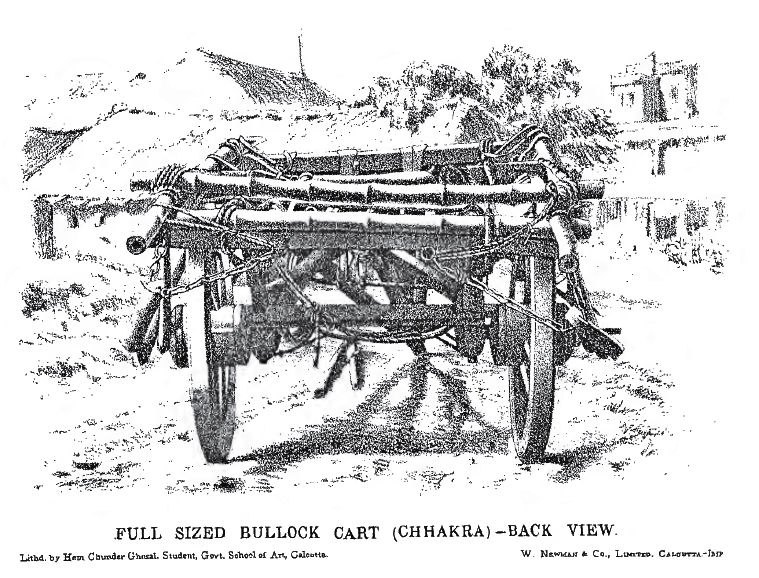
Abb.: गन्त्री । Wagen
(cakra) Bihār, 19. Jhdt.
[Bildquelle: Grierson, George Abraham <1851-1941>: Bihār
peasant life : being a discursive catalogue of the surroundings of the
people of that province. -- Calcutta : Bengal Secretariat Press, 1885. --
Vor S. 31.]
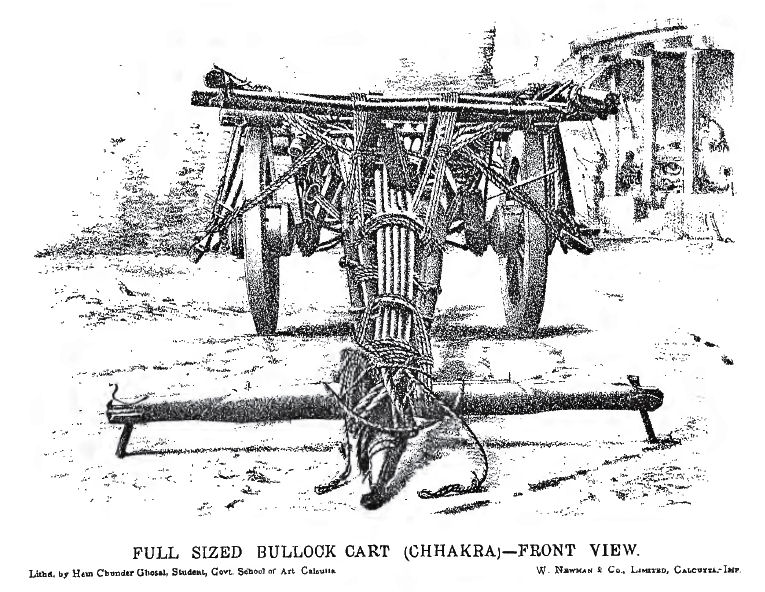
Abb.: गन्त्री । Wagen
(cakra) Bihār, 19. Jhdt.
[Bildquelle: Grierson, George Abraham <1851-1941>: Bihār
peasant life : being a discursive catalogue of the surroundings of the
people of that province. -- Calcutta : Bengal Secretariat Press, 1885. --
Vor S. 33.]
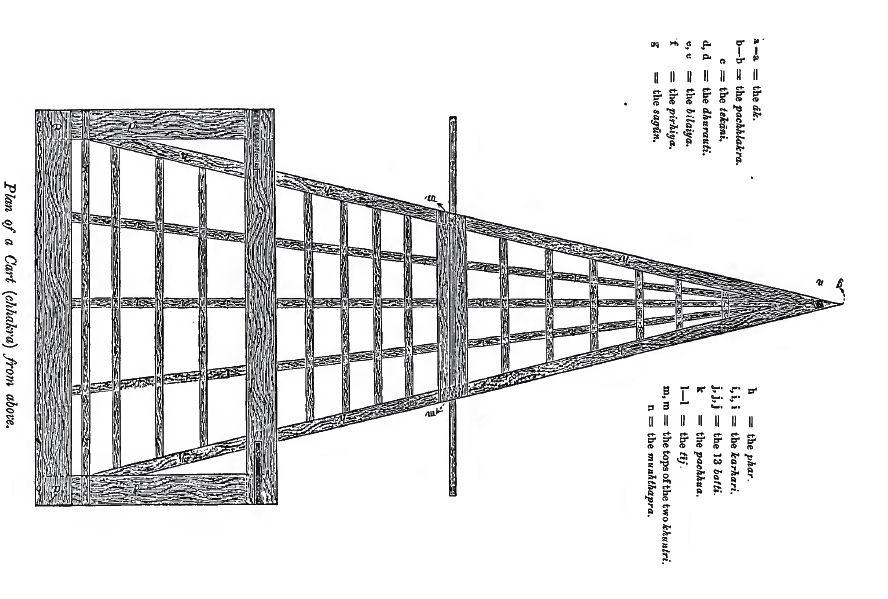
Abb.: गन्त्री । Wagen
(cakra) Bihār, 19. Jhdt.
[Bildquelle: Grierson, George Abraham <1851-1941>: Bihār
peasant life : being a discursive catalogue of the surroundings of the
people of that province. -- Calcutta : Bengal Secretariat Press, 1885. --
Vor S. 33.]
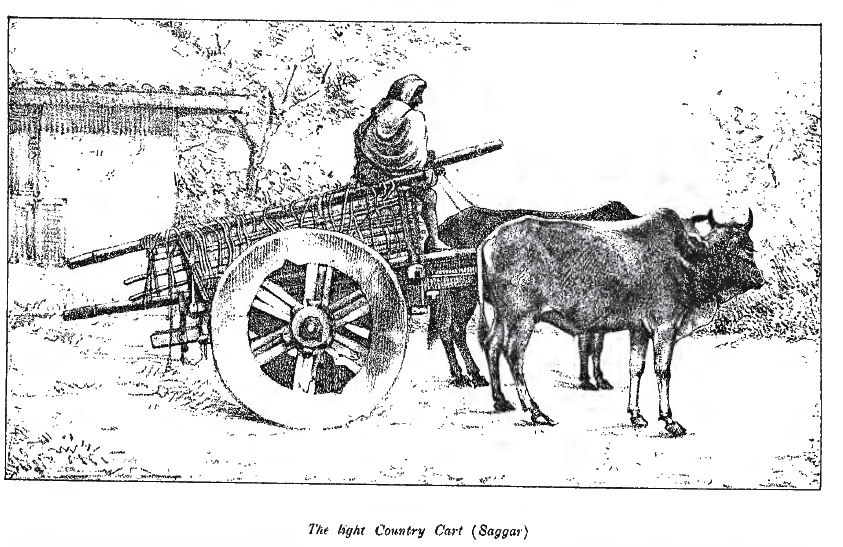
Abb.: गन्त्री । Wagen
(saggar) Bihār, 19. Jhdt.
[Bildquelle: Grierson, George Abraham <1851-1941>: Bihār
peasant life : being a discursive catalogue of the surroundings of the
people of that province. -- Calcutta : Bengal Secretariat Press, 1885. --
Vor S. 39.]
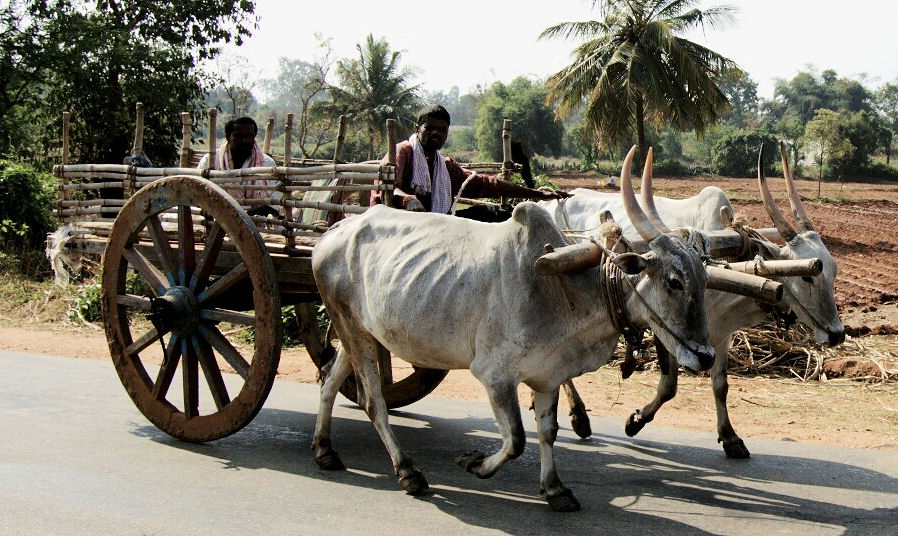
Abb.: गन्त्री । Karnataka
[Bildquelle: Sharath Sridhar. --
http://www.flickr.com/photos/sharath-sridhar/4397894344/. -- Zugriff am
2011-04-12. --
Creative
Commons Lizenz (Namensnennung, keine kommerzielle Nutzung, share alike)]
कम्बलिवाह्यक - kambalivāhyaka n.: mit einer Wolldecke (kambala) bedeckter Ochsenkarren
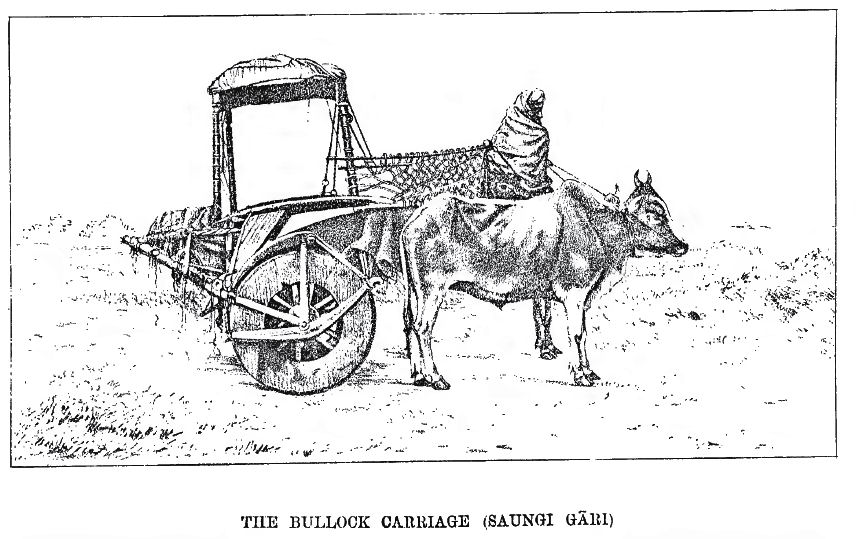
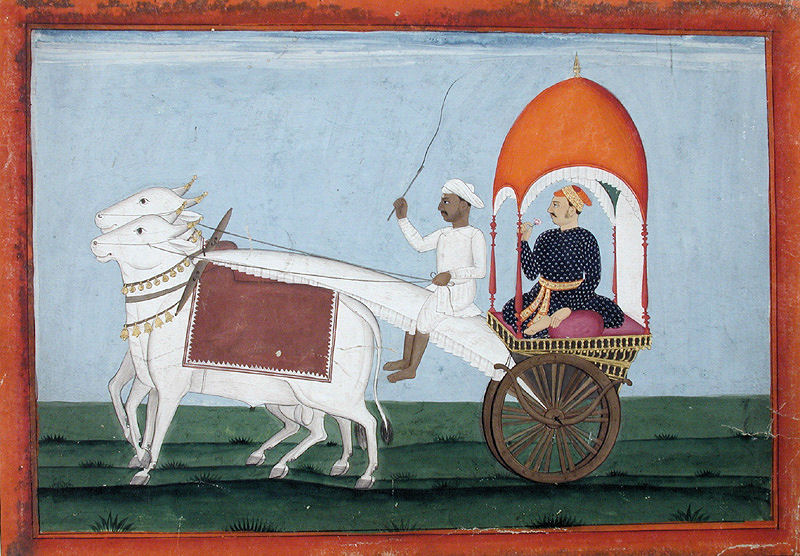
Abb.: कम्बलिवाह्यकम् । Vornehmer in Ochsenkarren, Tamil Nadu, ca. 1850
[Bildquelle: Asian Curator at The San Diego Museum of Art. --
http://www.flickr.com/photos/asianartsandiego/4837968339/. -- Zugriff am
2011-04-12. --
Creative Commons Lizenz (Namensnennung, keine kommerzielle Nutzung,
keine Bearbeitung)]
| 21a./b. śibikā yāpyayānaṃ syād dolā preṅkhādikāḥ striyām शिबिका याप्ययानं स्याद् दोला प्रेङ्खादिकाः स्त्रियाम् ।२१ क। [Bezeichnungen für Sänfte:]
|
Colebrooke (1807): "A litter."
शिबिका - śibikā f.: Sänfte, Leichenwagen
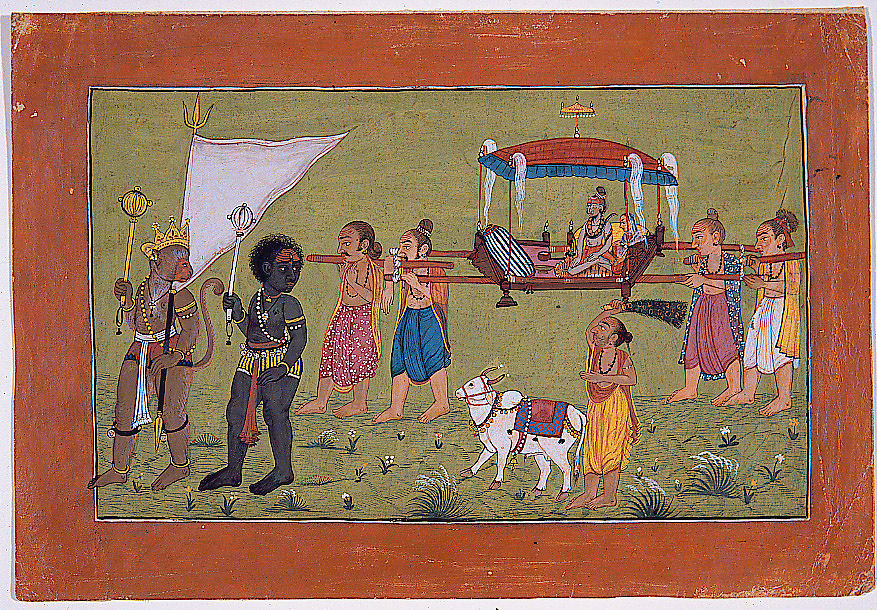
Abb.: शिबिका । Śiva und Pārvatī in Sänfte, Himachal Pradesh, ca. 1750
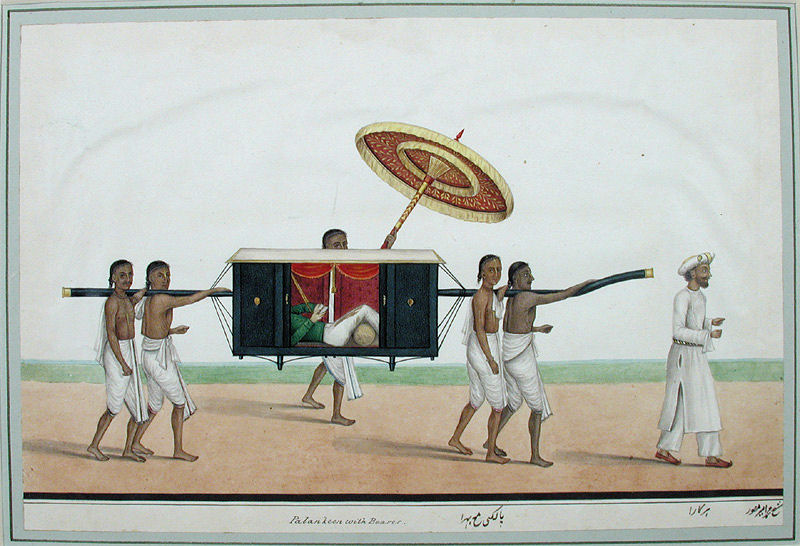
Abb.: शिबिका । Thomas Holroyd liest in der Sänfte, West Bengal, ca. 1835
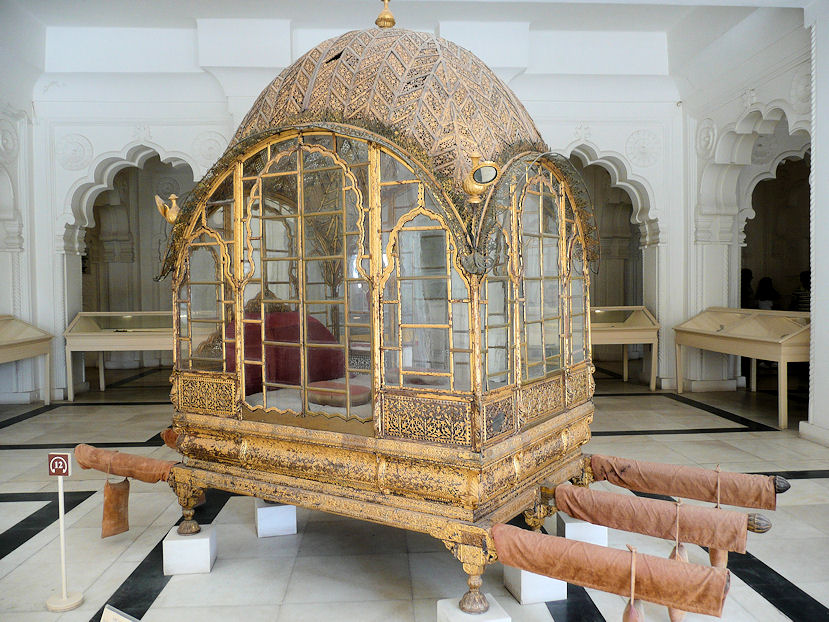
Abb.: शिबिका । Prunksänfte, Jodhpur - जोधाणा,
Rajasthan
[Bildquelle: Girl in the Rain. --
http://www.flickr.com/photos/graceandpoise/3375427040/. -- Zugriff am
2011-04-12. --
Creative Commons Lizenz (Namensnennung, keine kommerzielle Nutzung,
keine Bearbeitung)]
याप्ययान - yāpyayāna n.: "unbedeutendes Gefährt", Sänfte
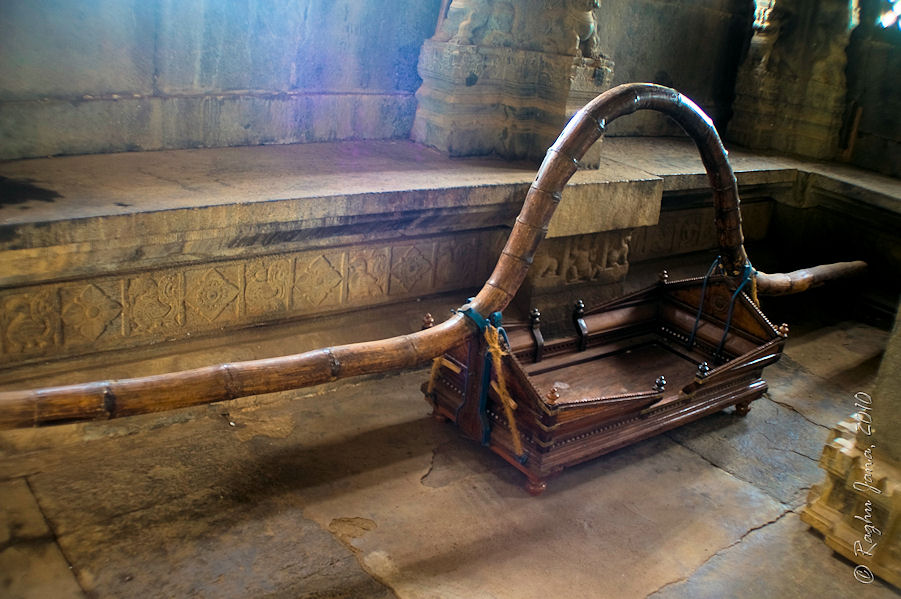
Abb.: याप्ययानम् । Sänfte, Ikkeri - ಇಕ್ಕೇರಿ,
Karnataka
[Bildquelle: Raghu Jana. --
http://www.flickr.com/photos/raghu7jana/4788671129/. -- Zugriff am
2011-04-12. -- Creative Commons Lizenz (Namensnennung, keine kommerzielle
Nutzung, keine Bearbeitung)]
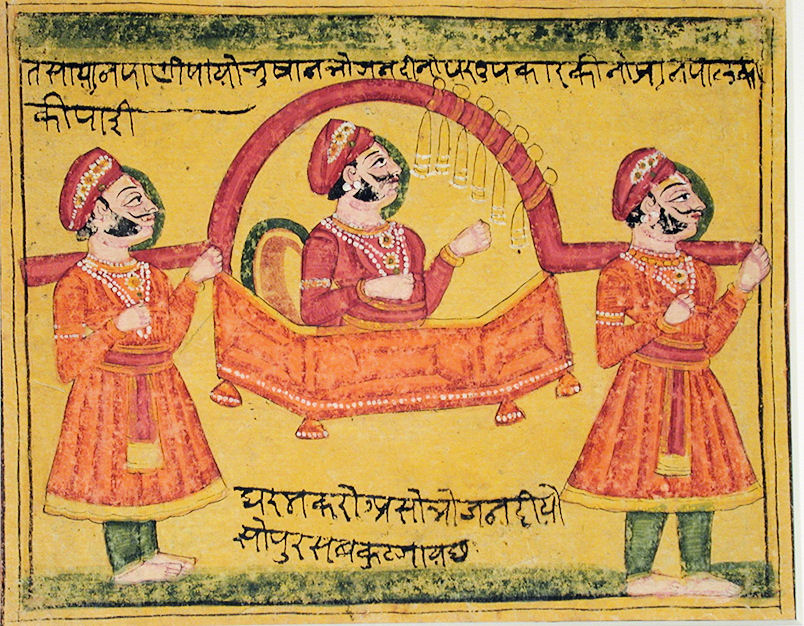
Abb.: याप्ययानम् । Mann in Sänfte, Rajasthan, ca. 1850
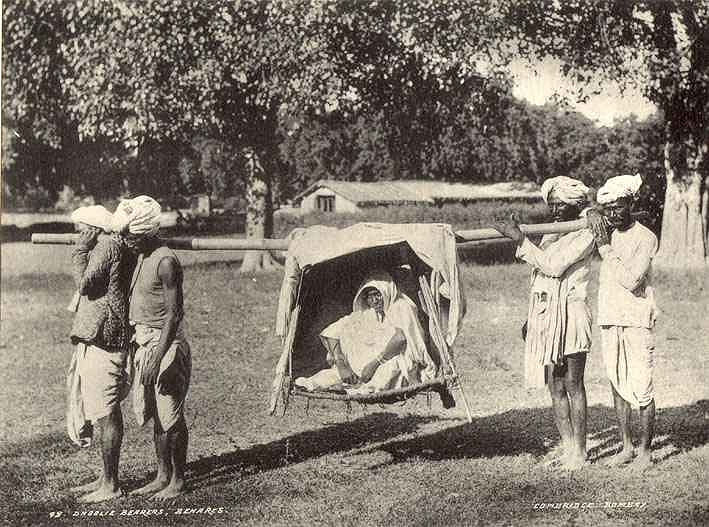
Abb.: याप्ययानम् । Sänfte, Varanasi - वाराणसी,
Uttar Pradesh, um 1890
[Bildquelle: Wikipedia. -- Public domain]
| 21a./b. śivikā yāpyayānaṃ syād
dolā preṅkhādikāḥ striyām शिविका याप्ययानं स्याद् दोला प्रेङ्खादिकाः स्त्रियाम् ।२१ क। [Bezeichnungen für Schaukel:]
|
Colebrooke (1807): "A hammock or swing. Whether for travelling or for diversion."
दोला - dolā f.: Schaukel
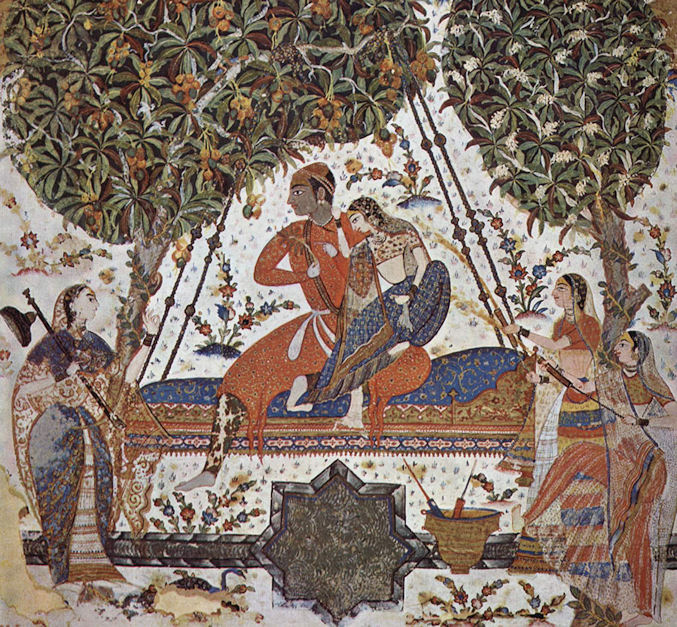
Abb.: दोला । Hindola Rāga, 1580/90
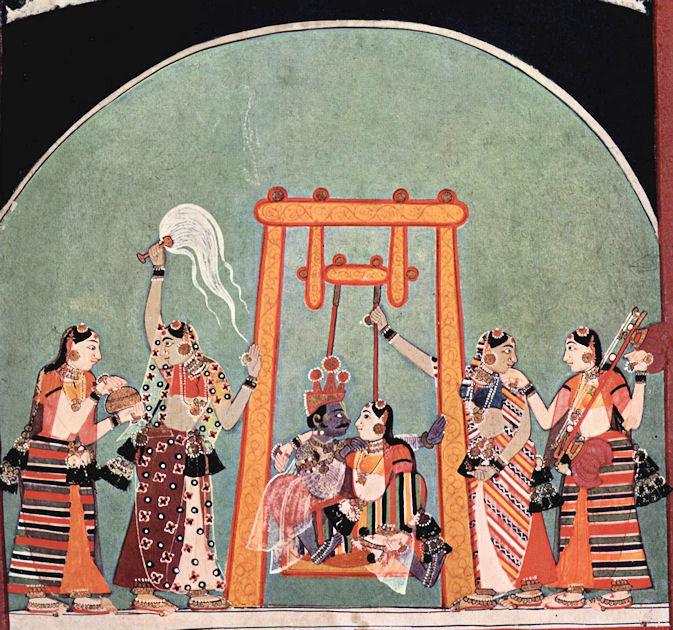
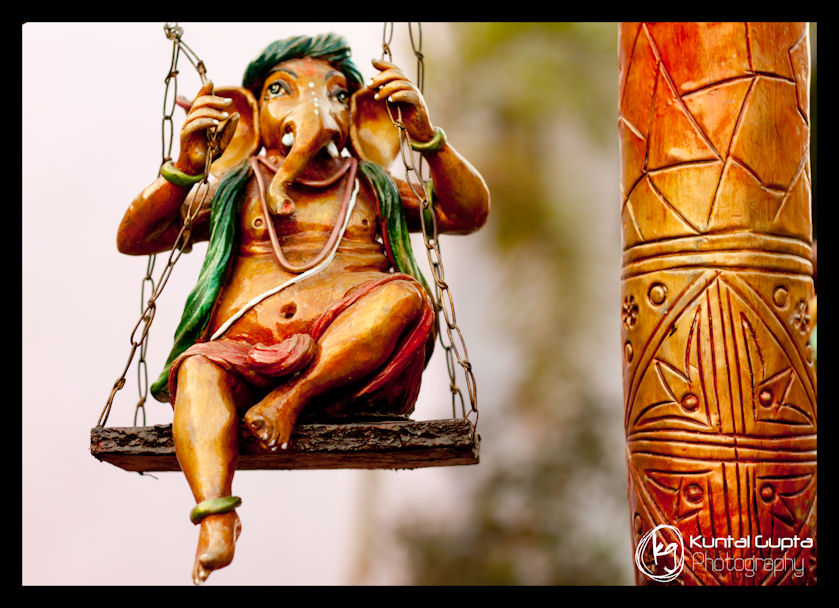
Abb.: दोला । Gaṇeśa, Kolkata -
কলকাতা, West Bengal
[Bildquelle: Kuntal Gupta. --
http://www.flickr.com/photos/cybercool10/5492825148/. -- Zugriff am
2011-06-06. --
Creative Commons Lizenz (Namensnennung, keine kommerzielle Nutzung,
keine Bearbeitung)]

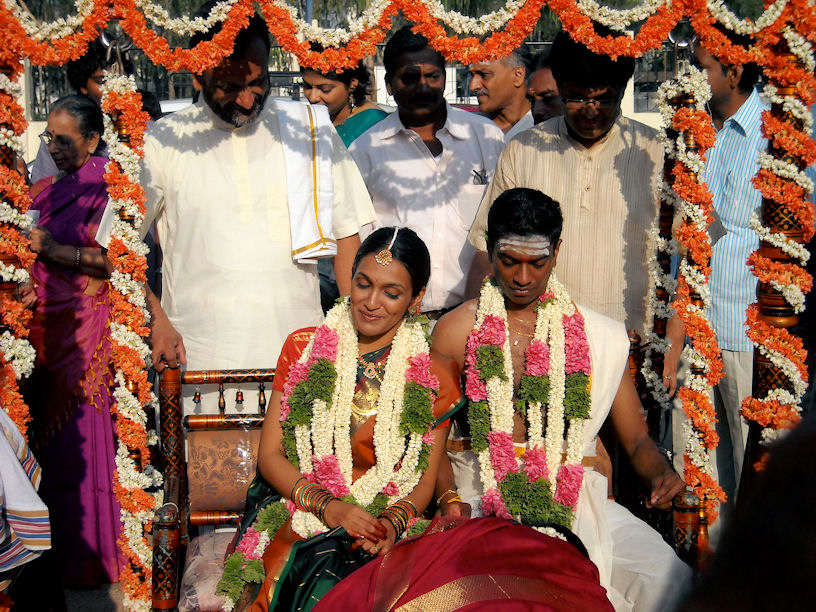
प्रेङ्खा - preṅkhā f.: Schaukel
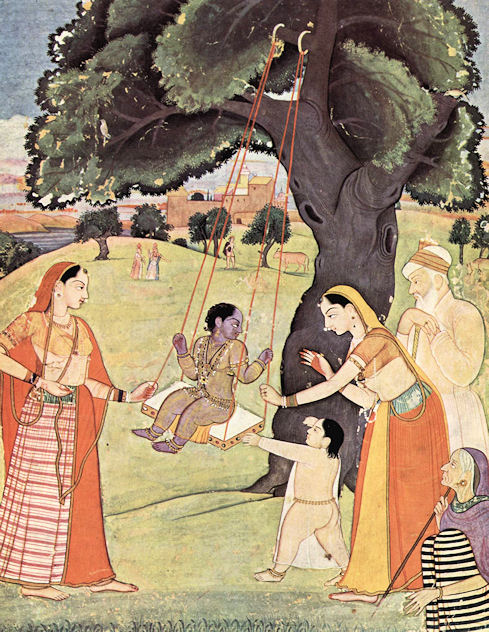
Abb.: प्रेङ्खा । Kṛṣṇa auf der Schaukel, 1750/1760
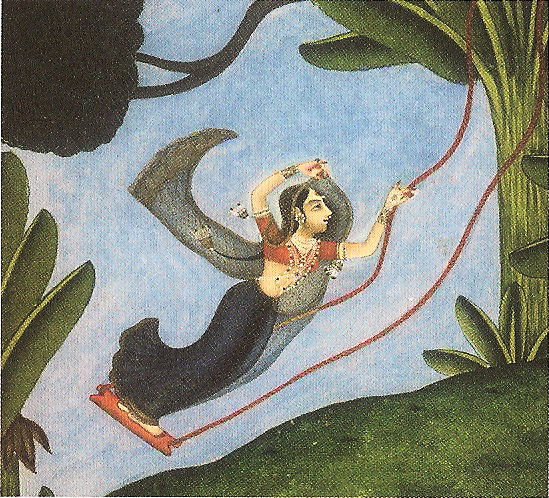
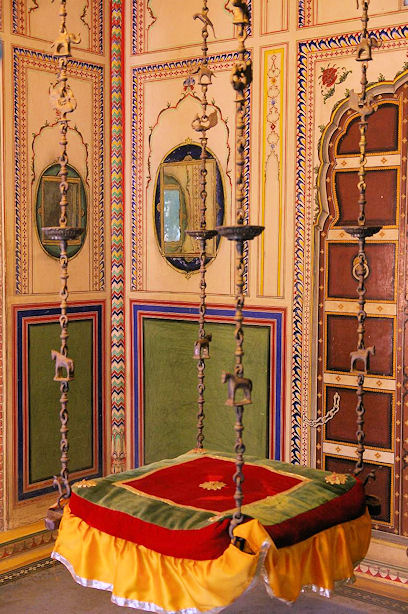
Abb.: प्रेङ्खा । Udaipur - उदयपुर, Rajasthan
[Bildquelle: Andrea Kirkby. --
http://www.flickr.com/photos/andreakirkby/5486918522/. -- Zugriff am
2011-06-06. --
Creative Commons Lizenz (Namensnennung, keine kommerzielle Nutzung)]
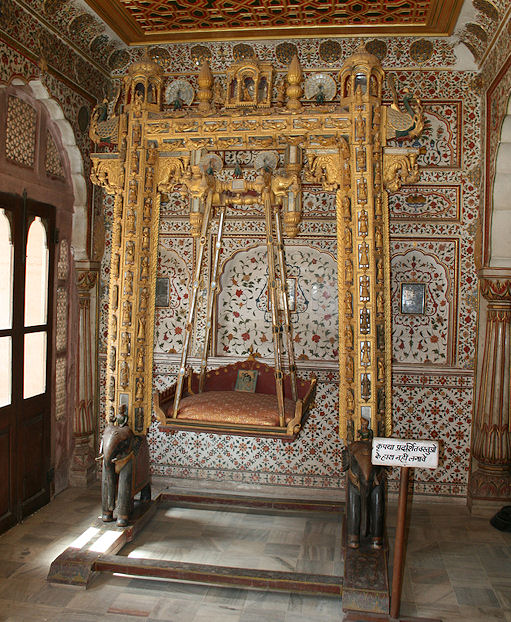
"Preṅkha, 'swing,' is mentioned in the description of the Mahāvrata rite, given in the Kāṭhaka Saṃhitā,1 the Aitareya Āraṇyaka,2 the Pañcaviṃśa Brāhmaṇa,3 and elsewhere.4 As far as can be judged from the notices available,5 the swing was made just like a modern swing. See also Pleṅkha.
1 i- 2, 3. 4 ; V. I, 3, etc.
2 V. 5, 7.
3 Sāṅkhāyana Āraṇyaka, ii. 17, etc.
4 Sāṅkhāyana Śrauta Sūtra, xvii. 1, 11 ; 7, 2, etc."[Quelle: MacDonell, Arthur Anthony <1854 - 1930> ; Keith, Arthur Berriedale <1879 - 1944>: Vedic index of names and subjects. -- London . Murray, 1912. -- 2 Bde. -- Bd. 2. -- S. 52f.]
|
21c./d. ubhau tu dvaipa-vaiyāghrau
dvīpicarmāvṛte rathe उभौ तु द्वैप-वयाघ्रौ द्वीपिचर्मावृते रथे ॥२१ ख॥ Bezeichnungen für einen mit einem Tigerfell bzw. Leopardenfell bedeckten Wagen:
|
Colebrooke (1807): "A car covered with tigerskin. The following terms are employed adjectively.
|
22a./b. pāṇḍu-kambala-saṃvītaḥ syandanaḥ
pāṇḍukambalī पाण्डु-कम्बल-संवीतः स्यन्दनः पाण्डुकम्बली ।२२ क। Ein mit einem weißen Wollstoff umgebener Wagen heißt पाण्डुकम्बलिन् - pāṇḍukambalin 3: "mit einer weißen Wolldecke" |
Colebrooke (1807): "with woollen cloth."
|
22c./d. rathe kāmbala-vāstrādyāḥ kambalādibhir
āvṛte रथे काम्बल-वास्त्राद्याः कम्बलादिभिर् आवृते ॥२२ ख॥ Bezeichnungen für einen Wagen, der mit Wollstoff (kambala) u. ä. bedeckt ist:
|
Colebrooke (1807): "with blanket or cloth, &c."
काम्बल - kāmbala 3: mit Wolldecke, mit Wolltuch
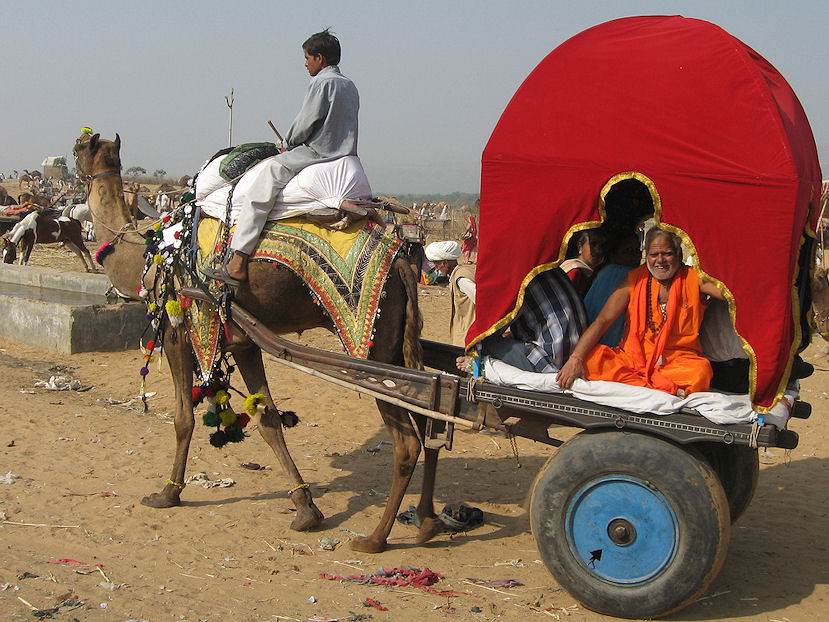
Abb.: काम्बलः । Pushkar - पुष्कर, Rajasthan
[Bildquelle: Dan.be. --
http://www.flickr.com/photos/70534225@N00/391397899/. -- Zugriff am
2011-04-13. --
Creative Commons Lizenz (Namensnennung, keine kommerzielle Nutzung,
keine bearbeitung)]
वास्त्र - vāstra 3: mit Tuch
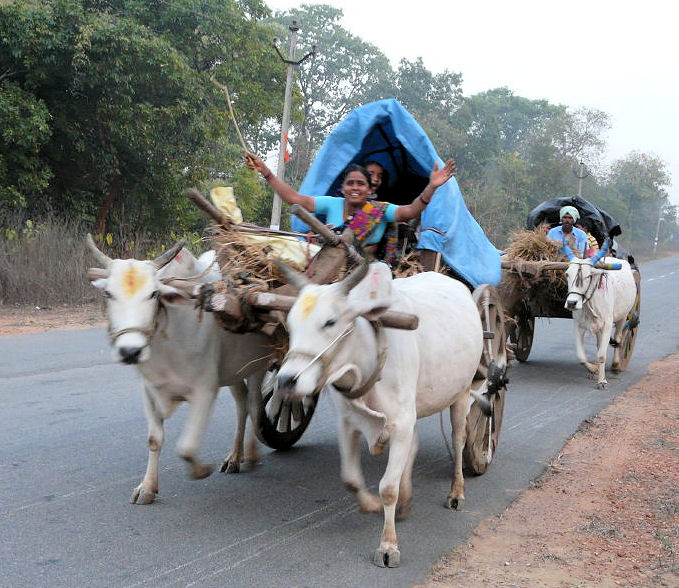
Abb.: वास्त्रः । Wrangal District - వరంగల్
జిల్లా, Andhra Pradesh
[Bildquelle: jankie. --
http://www.flickr.com/photos/jajankie/4392586398/. -- Zugriff am
2011-06-06. --
Creative
Commons Lizenz (Namensnennung, keine kommerzielel Nutzung, share alike)]
दार्व - dārva m.: hölzern
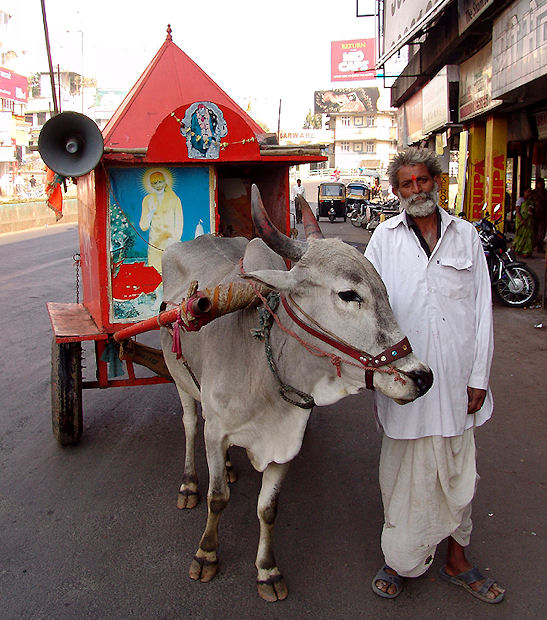
Abb.: दार्वः । Pune, Maharashtra
[Bildquelle: Sutherland. --
http://www.flickr.com/photos/zen/383856642/. -- Zugriff am 2011-06-06.
--
Creative Commons Lizenz (Namensnennung, keine kommerzielle Nutzung,
share alike)]
|
23a./b. triṣu dvaipādayo
rathyā rathakaḍyā rathavraje त्रिषु द्वैपादयो रथ्या रथकड्या रथव्रजे ।२३ क। dvaipa (Vers 21c) und die Folgenden kommen in den drei grammatischen Geschlechtern vor (sind Adjektive). |
|
23a./b. triṣu dvaipādayo
rathyā rathakaḍyā rathavraje त्रिषु द्वैपादयो रथ्या रथकड्या रथव्रजे ।२३ क। Bezeichnungen für eine Ansammlung von Wagen:
|
Colebrooke (1807): "A multitude of cars."
रथ्या - rathyā f.: Ansammlung von Wagen
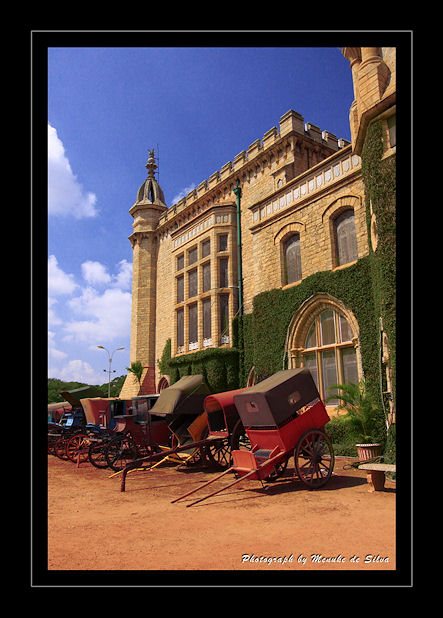
Abb.: रथ्या । Bangalore -
ಬೆಂಗಳೂರು, Karnataka
[Bildquelle: Menuke de Silva. --
http://www.flickr.com/photos/menuke/5186854910/. -- Zugriff am
2011-06-06. --
Creative Commons Lizenz (Namensnennung, keine kommerzielle Nutzung,
keine Bearbeitung)]
रथकड्या - rathakaḍyā f.: Ansammlung von Wagen
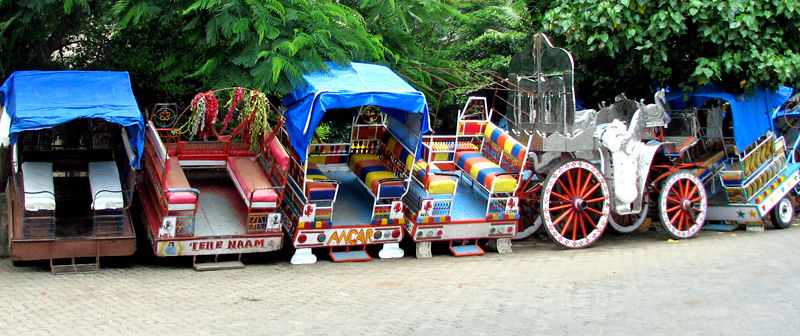
Abb.:
|
23c./d. dhūḥ strī klībe yānamukhaṃ syād rathāṅgam apaskaraḥ धूः स्त्री क्लीबे यानमुखं स्याद् रथाङ्गम् अपस्करः ॥२३ ख॥ Der vorderste Teil eines Fahrzeugs heißt धुर् - dhur f.: äußerste Spitze der Deichsel, vorderste Stelle |
Colebrooke (1807): "Fore-part of a carriage. Its pole ; or the part where the yoke is fixed."
धुर् - dhur f.: äußerste Spitze der Deichsel, vorderste Stelle
"Deichsel, die Stange zur Anschirrung der Zugtiere an Fahrzeugen, dient zum Lenken und Zurückhalten (Bremsen) der Fahrzeuge." [Quelle: Meyers großes Konversations-Lexikon. -- DVD-ROM-Ausg. Faksimile und Volltext der 6. Aufl. 1905-1909. -- Berlin : Directmedia Publ. --2003. -- 1 DVD-ROM. -- (Digitale Bibliothek ; 100). -- ISBN 3-89853-200-3. -- s.v.]
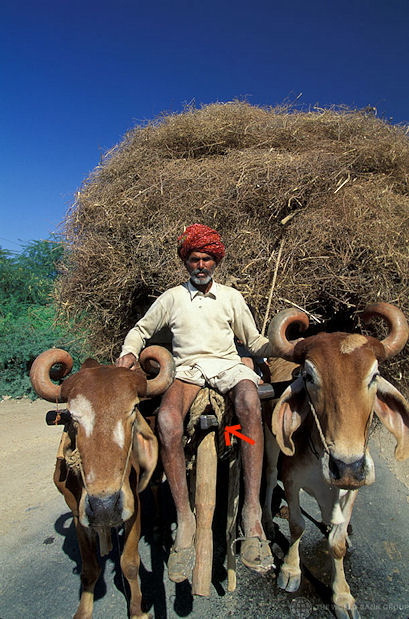
Abb.: धूः । Indien
[Bildquelle: World Bank / Curt Carnemark. --
http://www.flickr.com/photos/worldbank/2277349299/. -- Zugriff am
2011-04-13. --
Creative Commons Lizenz (Namensnennung, keine kommerzielle Nutzung,
keine Bearbeitung)]
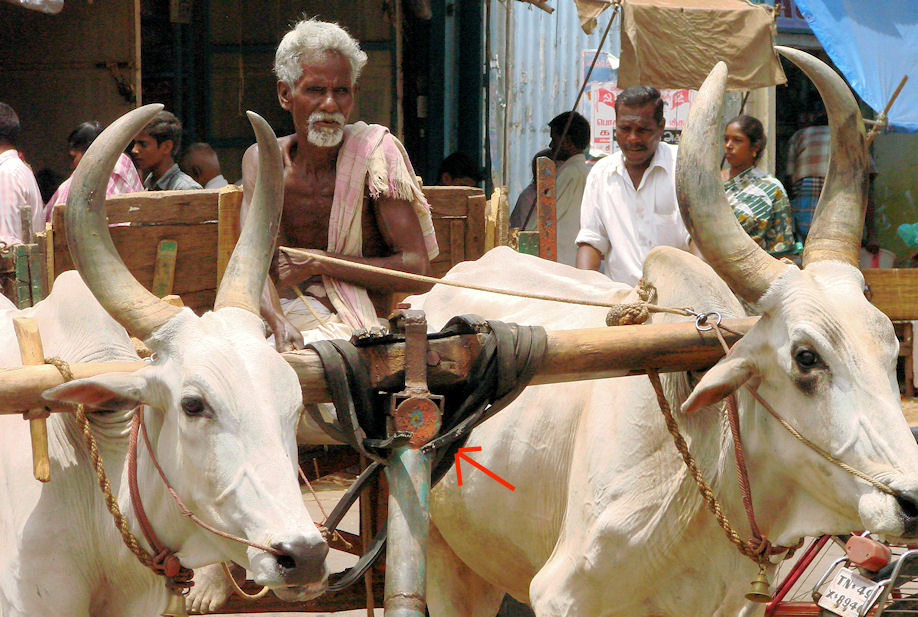
Abb.: धूः । Kumbakonam -
கும்பகோணம், Tamil Nadu
[Bildquelle: Adam Jones. --
http://www.flickr.com/photos/adam_jones/3774542272/. -- Zugriff am
2011-06-06. --
Creative
Commons Lizenz (Namensnennung, share alike)]
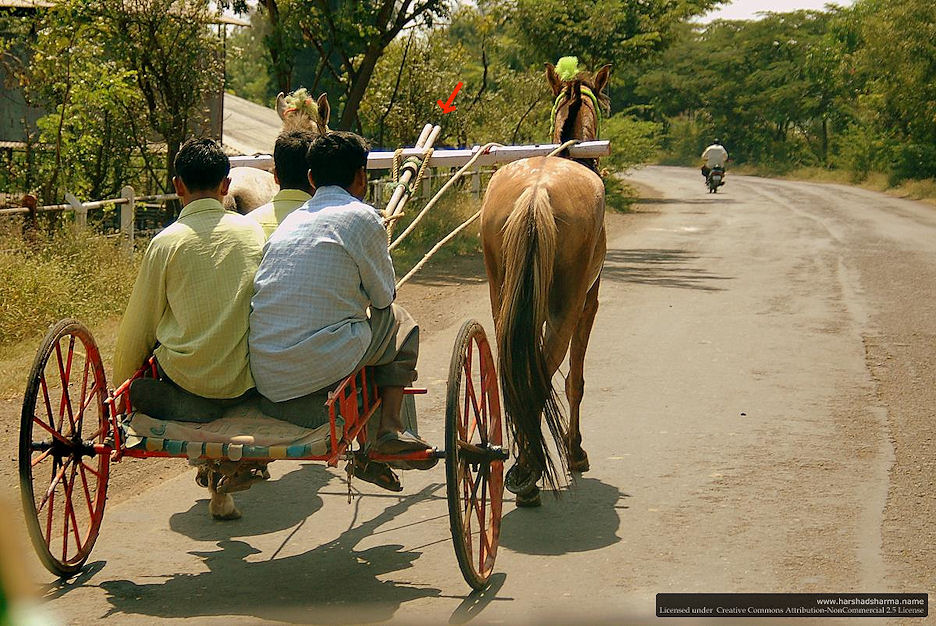
Abb.: धूः । Miraj - मिरज, Maharashtra
[Bildquelle: Harshad Sharma. --
http://www.flickr.com/photos/harshadsharma/280759363/. -- Zugriff am
2011-06-06. --
Creative Commons Lizenz (Namensnennung, keine kommerzielle Nutzung)]
|
23c./d. dhūḥ strī klībe yānamukhaṃ
syād rathāṅgam apaskaraḥ धूः स्त्री क्लीबे यानमुखं स्याद् रथाङ्गम् अपस्करः ॥२३ ख॥ [Bezeichnungen für Bestandteil eines Wagens:]
|
Colebrooke (1807): "Any part of a carriage."
|
24a./b. cakraṃ rathāṅgaṃ
tasyānte nemiḥ strī syāt pradhiḥ pumān चक्रं रथाङ्गं तस्यान्ते नेमिः स्त्री स्यात् प्रधिः पुमान् ।२४ क। [Bezeichnungen für Rad:]
|
Colebrooke (1807): "A wheel."
चक्र - cakra n.: Rad, Scheibe, Kreis
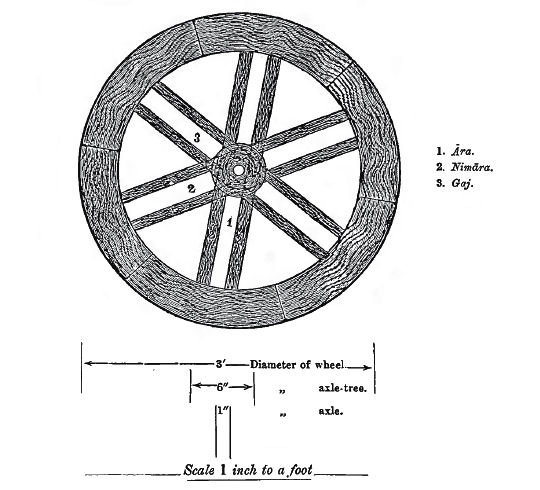
Abb.: चक्रम् । Rad eines Ochsenkarren, Bihar, 19. Jhdt
[Bildquelle: Grierson, George Abraham <1851-1941>: Bihār
peasant life : being a discursive catalogue of the surroundings of the
people of that province. -- Calcutta : Bengal Secretariat Press, 1885. -- S.
29.]
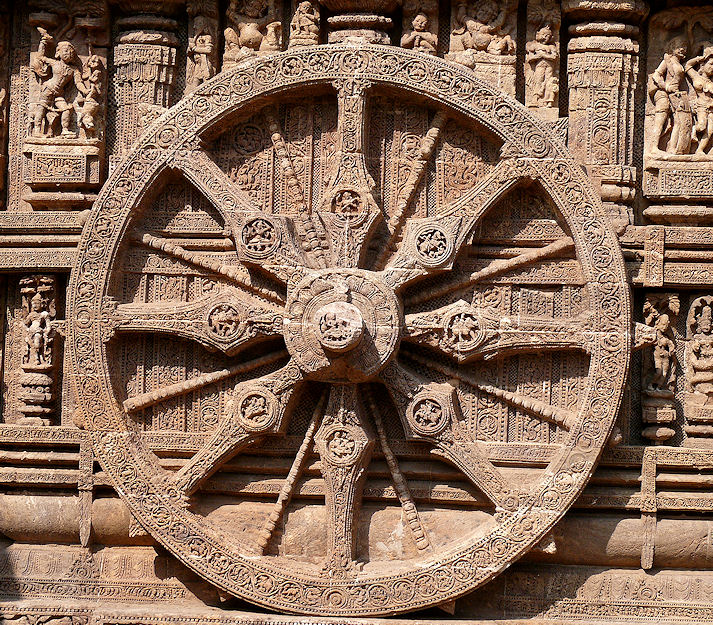
Abb.: चक्रम् । Konark - କୋଣାର୍କ, Orissa, 13.
Jhdt. n. Chr.
[Bildquelle: Rita Willaert. --
http://www.flickr.com/photos/rietje/346817100/. -- Zugriff am
2011-04-13. --
Creative Commons Lizenz (Namensnennung, keine kommerzielle Nutzung)]
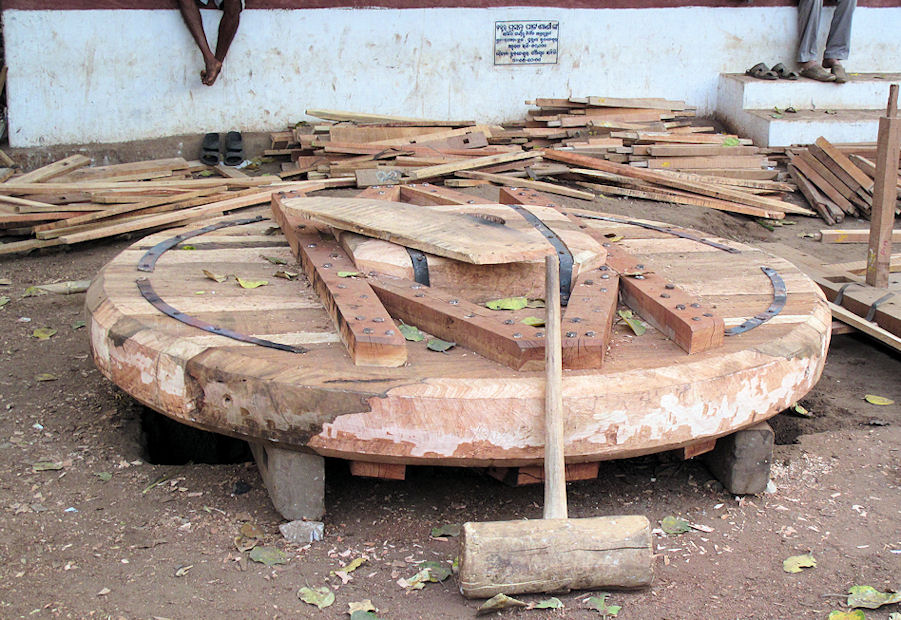
Abb.: चक्रम् । Bau eines Rads für Tempelwagen, Bhubaneswar -
ଭୁବନେଶ୍ବର, Orissa
[Bildquelle: Daniel Roy. --
http://www.flickr.com/photos/backpackfoodie/4440103337/in/photostream/.
-- Zugriff am 2011-06-06. --
Creative
Commons Lizenz (Namensnennung, keine kommerzielle Nutzung, share alike)]
रथाङ्ग - rathāṅga n.: Wagen-Bestandteil, Rad
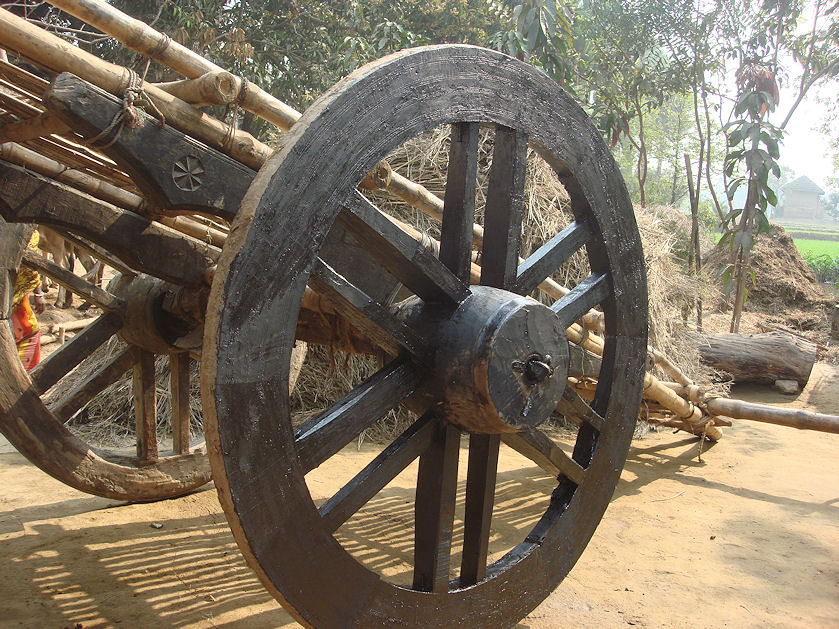
Abb.: रथाङ्गम् । West Bengal
[Bildquelle: ILRI/MacMillan. --
http://www.flickr.com/photos/ilri/5249676598/. -- Zugriff am 2011-04-13.
--
Creative Commons Lizenz (Namensnennung, keine kommerzielle Nutzung,
share alike)]
"Cakra, the 'wheel ' of a chariot or wagon, is repeatedly mentioned from the Rigveda1 onwards, often in a metaphorical sense. The wheel was fixed on the axle (Akṣa) when the chariot was required for use ; this required considerable strength, as is shown by a reference in the Rigveda.2 The wheel consisted normally of spokes (Ara), and a nave (Nābhi), 3 in the opening (Kha) of which the end of the axle (Āṇi) was inserted. An indication of the importance attached to the strength of the wheel is the celebration of the car of the god Pūṣan as having a wheel that suffers no damage.4 The usual number of wheels was two,5 but in seven passages of the Rigveda6 a chariot is called 'three-wheeled,' in a few others 'seven-wheeled,'7 while in one of the Atharvaveda8 it is styled 'eight-wheeled.' Zimmer9 argues that these epithets do not refer to real chariots, pointing out that in all the passages where tri-cakra, 'three-wheeled,' occurs there is a mythical reference. On the other hand, Weber10 thinks that there might have been chariots with three wheels, one being in the centre between the two occupants. This is not very conclusive ; at any rate, the seven-wheeled and the eight-wheeled chariots can hardly be regarded as indicating the existence of real vehicles with that number of wheels.
In the Śatapatha Brāhmaṇa11 the potter's wheel (kaulālacakra) is referred to.
1 i. 130, 9; 155, 6; 164, 2. 11. 14; 174, 5 ; iv, 1, 3. etc.
2 Av. xi. 7, 4 ; xix. 53, 1. 2, etc.
3 Rv. viii. 41, 6.
4 Rv. vi. 54, 3.
5 Rv. viii. 5, 29; Chāndogya Upaniṣad, iv. 16, 5 ; Kauṣītaki Upaniṣad, i. 4.
6 i. 118, 2; 157, 3; 183, 1; viii. 58, 3; x. 41, 1 ; 85, 14 (all of the Aśvins' chariot); iv. 36, 1 (of a chariot made by the Ṛbhus, who are three in number).
7 Rv. i. 164, 3. 12 ; ii. 40, 3.
8 xi. 4, 22.
9 Altindisches Leben, viii., ix.
10 Proceedings of the Berlin Academy, 1898, 564, quoting Virchow, Zeitschrift fur Ethnologie, 5, 200.
11 xi. 8, 1, 1.
Cf. Zimmer, op. cit., 247."[Quelle: MacDonell, Arthur Anthony <1854 - 1930> ; Keith, Arthur Berriedale <1879 - 1944>: Vedic index of names and subjects. -- London . Murray, 1912. -- 2 Bde. -- Bd. 1. -- S. 252]
|
24a./b. cakraṃ rathāṅgaṃ
tasyānte nemiḥ strī syāt pradhiḥ pumān चक्रं रथाङ्गं तस्यान्ते नेमिः स्त्री स्यात् प्रधिः पुमान् ।२४ क। Am (äußeren) Ende des Rads ist
|
Colebrooke (1807): "Its periphery."
नेमि - nemi f.: Radkranz, Felgen, Kreis
"Felgen, die krummen Hölzer, aus denen der Kranz (Felgenkranz) eines Mühl- oder Wagenrades zusammengesetzt ist; die einzelnen F. werden durch Dübel verbunden u. durch den Radreifen zusammengehalten." [Quelle: Meyers großes Konversations-Lexikon. -- DVD-ROM-Ausg. Faksimile und Volltext der 6. Aufl. 1905-1909. -- Berlin : Directmedia Publ. --2003. -- 1 DVD-ROM. -- (Digitale Bibliothek ; 100). -- ISBN 3-89853-200-3. -- s.v.]
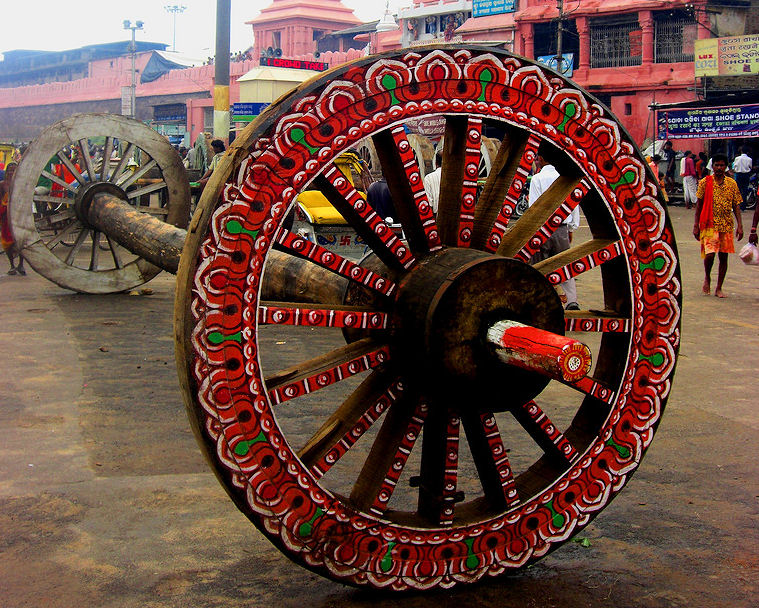
Abb.: नेमिः । Rad für Tempelwagen, Puri - ପୁରୀ,
Orissa
[Bildquelle: Sourav Das. --
http://www.flickr.com/photos/souravdas/2790490358/. -- Zugriff am
2011-06-06. --
Creative
Commons Lizenz (Namensnennung)]
प्रधि - pradhi f.: Radkranz, Felgen
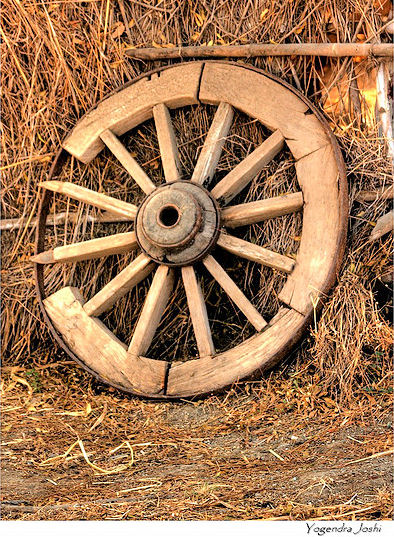
Abb.: प्रधिः । bei Pune - पुणे,
Maharashtra
[Bildquelle: Yogendra Joshi. --
http://www.flickr.com/photos/yogendra174/4413277358/. -- Zugriff am
2011-06-06. --
Creative
Commons Lizenz (Namensnennung)]
|
24c./d. piṇḍikā nābhir akṣāgrakīlake tu dvayor aṇiḥ पिण्डिका नाभिर् अक्षाग्रकीलके तु द्वयोर् अणिः ॥२४ ख॥ [Bezeichnungen für Nabe:]
|
Colebrooke (1807): "Its nave. Or else the centre piece of the car itself."
"Nabe, hülsenförmige Teile von Maschinenteilen, besonders Rädern, Scheiben, Rollen, Kurbeln und Hebeln, mit denen diese auf Stangen, Wellen, Achsen u. dgl. befestigt werden." [Quelle: Meyers großes Konversations-Lexikon. -- DVD-ROM-Ausg. Faksimile und Volltext der 6. Aufl. 1905-1909. -- Berlin : Directmedia Publ. --2003. -- 1 DVD-ROM. -- (Digitale Bibliothek ; 100). -- ISBN 3-89853-200-3. -- s.v.]
पिण्डिका - piṇḍikā f.: kugelförmige Anschwellung, Wade, Nabe
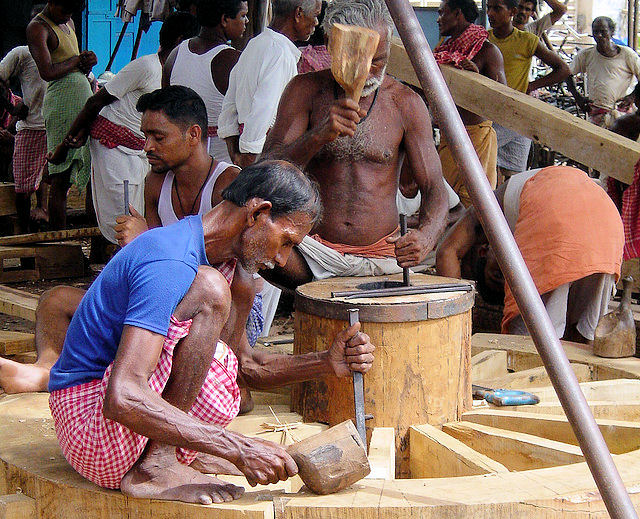
नाभि - nābhi f.: Nabel, Nabelschnur, Radnabe, Mittelpunkt, Ursprung

Abb.: नाभिः । Konark - କୋଣାର୍କ, Orissa, 13.
Jhdt. n. Chr.
[Bildquelle: Shayan (USA). --
http://www.flickr.com/photos/ssanyal/347792526/. -- Zugriff am
2011-04-13. --
Creative
Commons Lizenz (Namensnennung)]
|
24c./d. piṇḍikā nābhir
akṣāgrakīlake tu dvayor aṇiḥ पिण्डिका नाभिर् अक्षाग्रकीलके तु द्वयोर् अणिः ॥२४ ख॥ Der Holzpflock am Ende der Achse heißt अणि - aṇi m., f.: Achszapfen, Achsennagel |
Colebrooke (1807): "The pin of the axle. Or a pin at the extremity of the pole."
अणि - aṇi m., f.: Achszapfen, Achsennagel
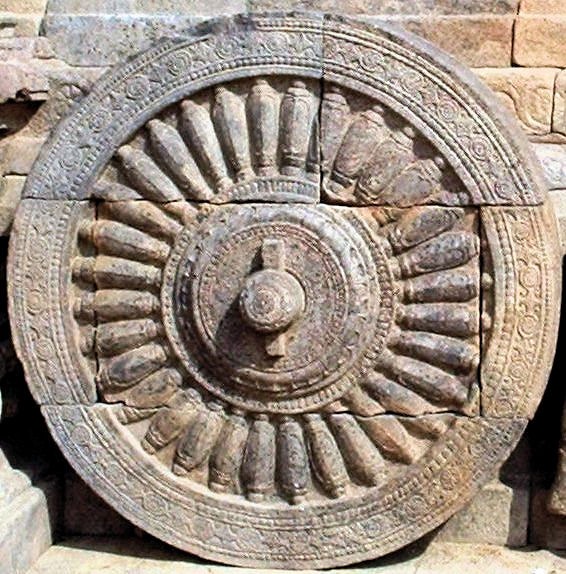
Abb.: अणिः Darasuram - தாராசுரம், Tamil Nadu
[Bildquelle: Balaji B. --
http://www.flickr.com/photos/bbalaji/2443820505/. -- Zugriff am
2011-04-13. --
Creative
Commons Lizenz (Namensnennung)]
|
25a./b. rathaguptir varūtho nā kūbaras tu yugandharaḥ रथगुप्तिर् वरूथो ना कूबरस् तु यगन्धरः ।२५ क। [Bezeichnungen für Stoßstange:]
|
Colebrooke (1807): "The fender of a carriage. A piece of wood encompassing it, to secure it from collision."
वरूथ - varūtha m.: Wehr, am Wagen zum Schutz angebrachte Einfassung
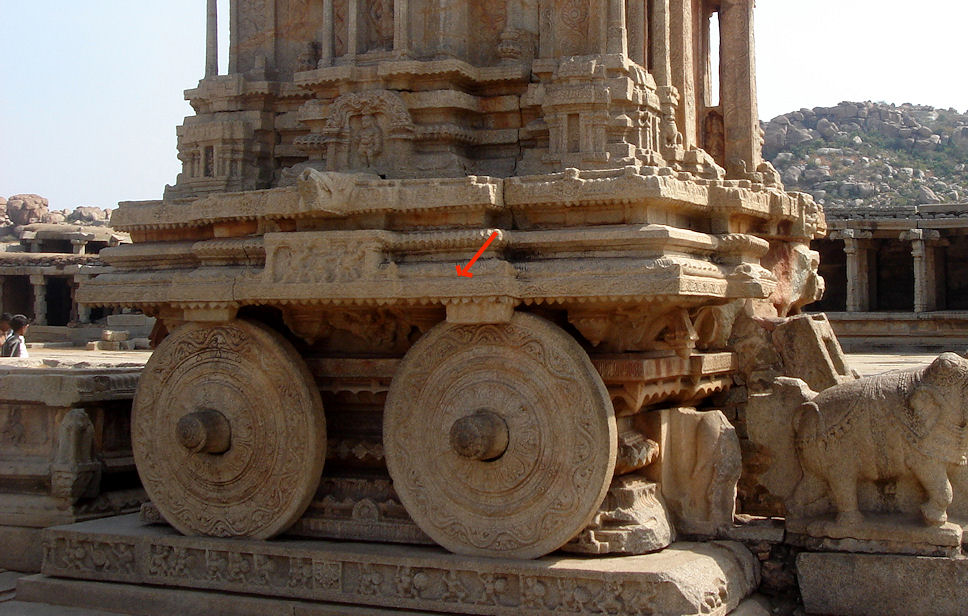
Abb.: वरूथः । Hampi -
|
25a./b. rathaguptir varūtho nā
kūbaras tu yugandharaḥ रथगुप्तिर् वरूथो ना कूबरस् तु युगन्धरः ।२५ क। [Bezeichnungen für Deichsel:]
|
Colebrooke (1807): "The pole. Or wood to which the yoke is fixed."
"Deichsel, die Stange zur Anschirrung der Zugtiere an Fahrzeugen, dient zum Lenken und Zurückhalten (Bremsen) der Fahrzeuge." [Quelle: Meyers großes Konversations-Lexikon. -- DVD-ROM-Ausg. Faksimile und Volltext der 6. Aufl. 1905-1909. -- Berlin : Directmedia Publ. --2003. -- 1 DVD-ROM. -- (Digitale Bibliothek ; 100). -- ISBN 3-89853-200-3. -- s.v.]
कूबर - kūbara m.: Deichsel
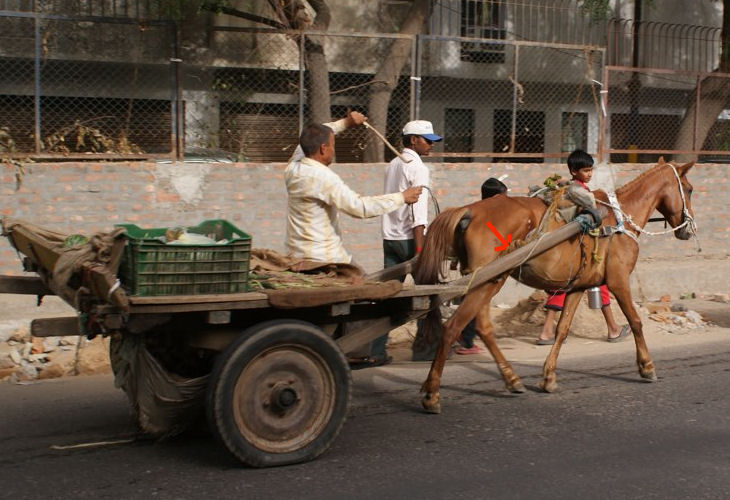
Abb.: कूबरः । Delhi
[Bildquelle: Nicolas Sanguinetti. --
http://www.flickr.com/photos/foca/5796400660/. -- Zugriff am 2011-06-07.
-- Creative
Commons Lizenz (Namensnennung, share alike)]
यु
गन्धर - yugandhara m.: Jochträger
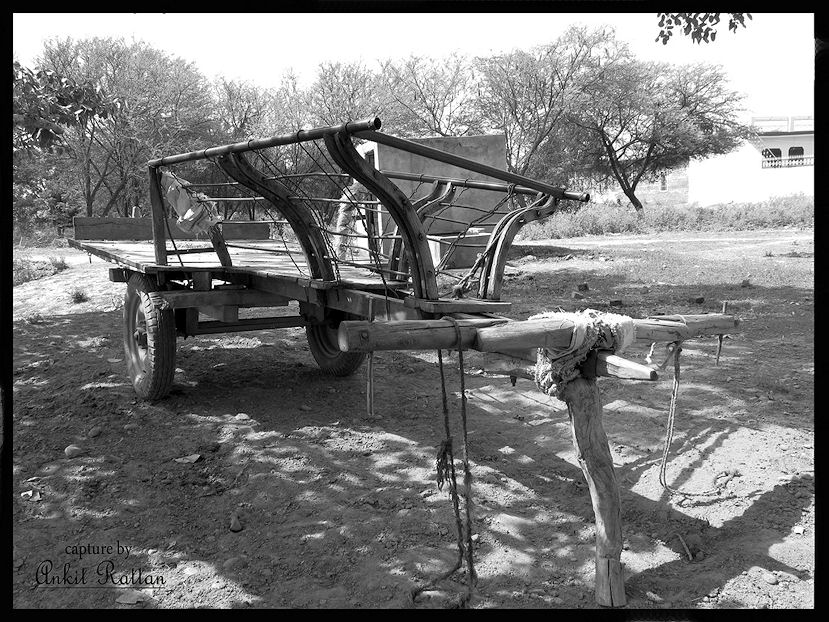
Abb.: युगन्धरः । Indien
[Bildquelle: Ankil Rattan. --
http://www.flickr.com/photos/ankitrattanar/5804462592/. -- Zugriff am
2011-06-07. --
Creative Commons Lizenz (Namensnennung, keine kommerzielle Nutzung,
keine Bearbeitung)]
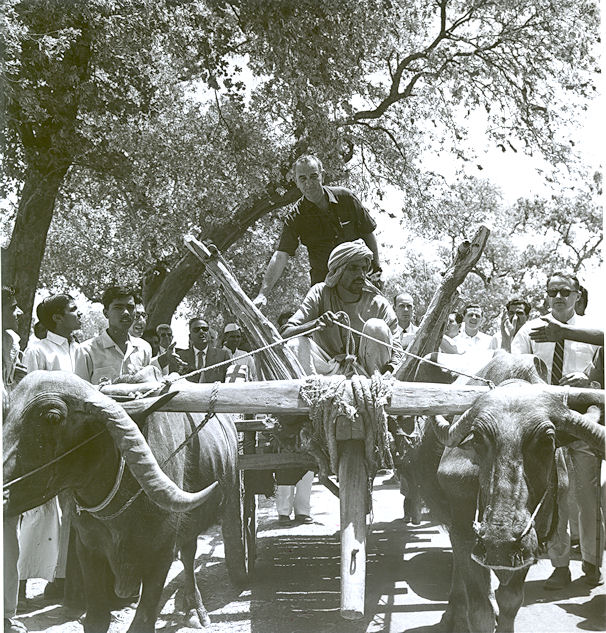
Abb.: युगन्धरः । US-Vizepräsident Lyndon B. Johnson, bei Agra -
आगरा, Uttar Pradesh, 1961-05-19
[Bildquelle: U. S. Embassy New Delhi. --
http://www.flickr.com/photos/usembassynewdelhi/5725066657/. -- Zugriff
am 2011-06-07. --
Creative Commons Lizenz (Namensnennung, keine Bearbeitung)]
|
25c./d. anukarṣo dārv adhaḥsthaṃ prāsaṅgo nā yugād yugaḥ अनुकर्षो दार्व् अधःस्थं प्रासङ्गो ना युगाद् युगः ॥२५ ख॥ Das Holz, das sich unterhalb (des Wagens) befindet, heißt अनुकर्ष - anukarṣa m.: das Nachsichziehen, Boden eines Wagens |
Colebrooke (1807): "Bottom of a carriage."
अनुकर्ष - anukarṣa m.: das Nachsichziehen, Boden eines Wagens
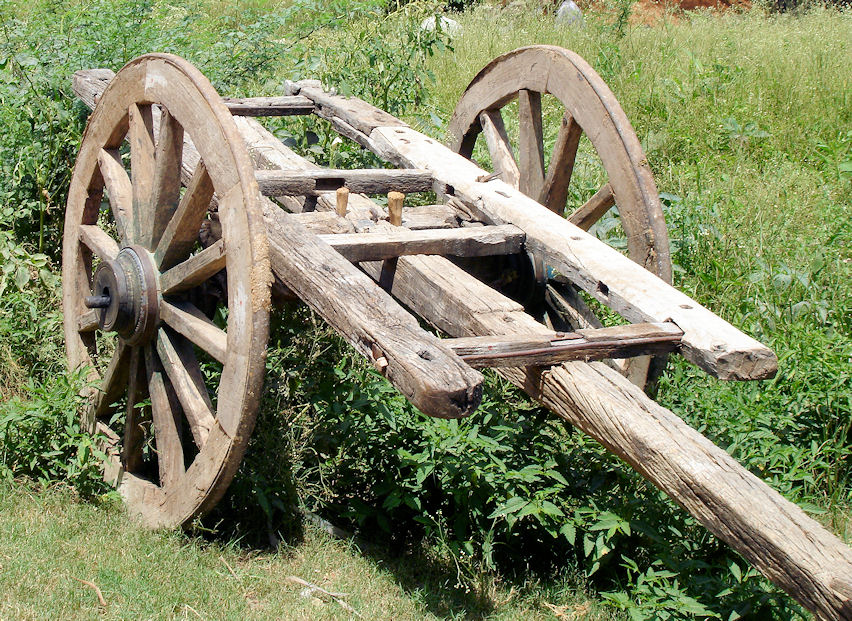
Abb.: अनुकर्षः । Bagepalli - ಬಾಗೆಪಲ್ಲಿ, Karnataka
[Bildquelle: Mikhail Esteves. --
http://www.flickr.com/photos/jackol/49308746/. -- Zugriff am 2011-06-07.
-- Creative
Commons Lizenz (Namensnennung)]
|
25c./d. anukarṣī dārvadhaḥsthaṃ
prāsaṅgo nā yugād yugaḥ अनुकर्षी दार्वधःस्थं प्रासङ्गो ना युगाद् युगः ॥२५ ख॥ Ein vom Joch verschiedenes Joch heißt प्रासङ्ग - prāsaṅga m.: "Anhafter", Nebenjoch |
Colebrooke (1807): "A separate yoke. For training young cattle and for similar purposes."
|
26a./b. sarvaṃ syād vāhanaṃ yānaṃ yugyaṃ patraṃ
ca dhāraṇam सर्वं स्याद् वाहनं यानं युग्यं पत्रं च धारणम् ।२६ क। All das heißt
|
Colebrooke (1807): "Any vehicle. Horse, elephant, chariot, &c."
वाहन - vāhana n.: Beförderungsmittel, Fahrzeug, Zugtier
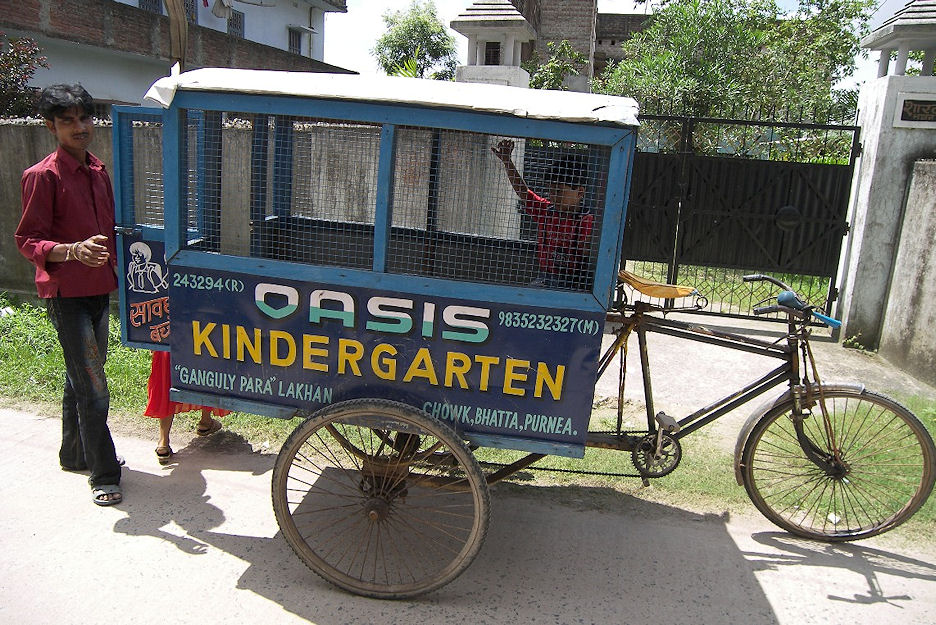
Abb.: वाहनम् । Purnia - पुर्णिया, Bihar
[Bildquelle: Jim. --
http://www.flickr.com/photos/yumievriwan/2777567289/. -- Zugriff am
2011-06-07. --
Creative Commons Lizenz (Namensnennung, keine kommerzielle Nutzung,
keine Bearbeitung)]

Abb.: वाहनम् । Handkarren zur Essenbeförderung durch Dabbawallas (डबेवाला),
Mumbai - मुंबई, Maharashtra
[Bildquelle: Meena Kadri. --
http://www.flickr.com/photos/meanestindian/4154669100/. -- Zugriff am
2011-06-07. --
Creative Commons Lizenz (Namensnennung, keine kommerzielle Nutzung,
keine Bearbeitung)]
यान - yāna n.: Fahrzeug
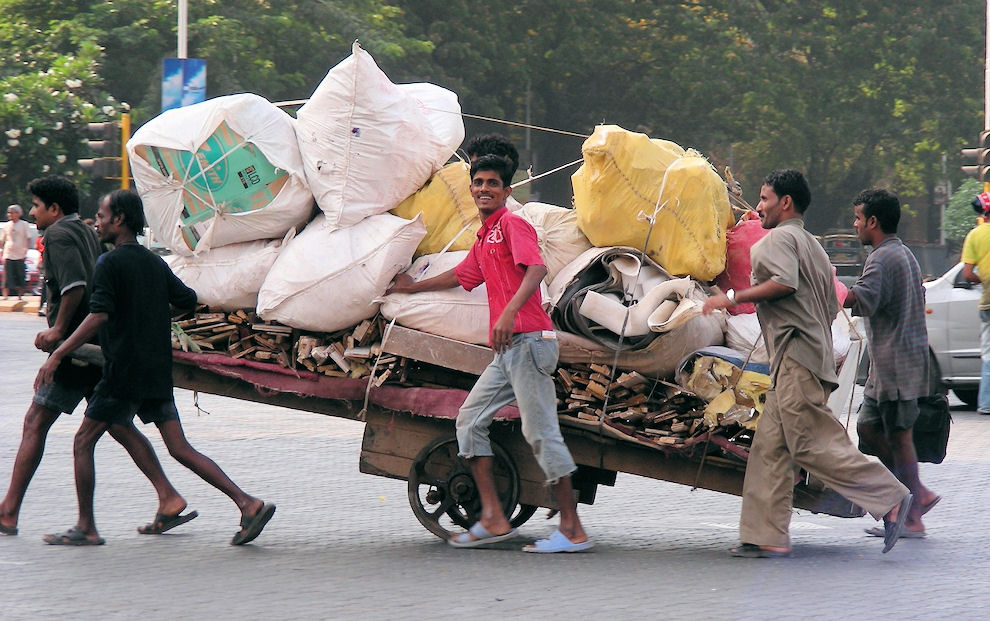
Abb.: यानम् । Mumbai - मुंबई, Maharashtra
[Bildquelle: Kristina D.C. Hoeppner. --
http://www.flickr.com/photos/4nitsirk/2809577374/. -- Zugriff am
2011-06-07. --
Creative
Commons Lizenz (Namensnennung, share alike)]
युग्य - yugya n.: "Anzuschirrendes", (Joch-)Fahrzeug, Zugtier
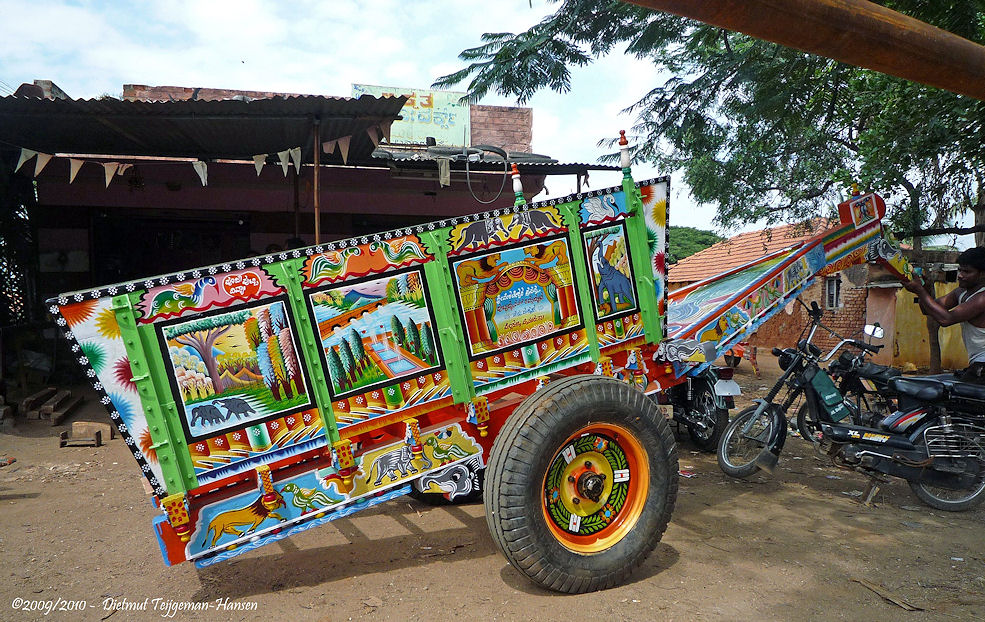
Abb.: युग्यम् । Karnataka
[Bildquelle: Dietmut Teijgeman-Hansen. --
http://www.flickr.com/photos/reisgekki/4270721147/. -- Zugriff am
2011-06-07. --
Creative Commons Lizenz (Namensnennung, keine kommerzielle Nutzung,
keine Bearbeitung)]
पत्र - patra n.: Flügel, Pferd, Zugtier, Wagen
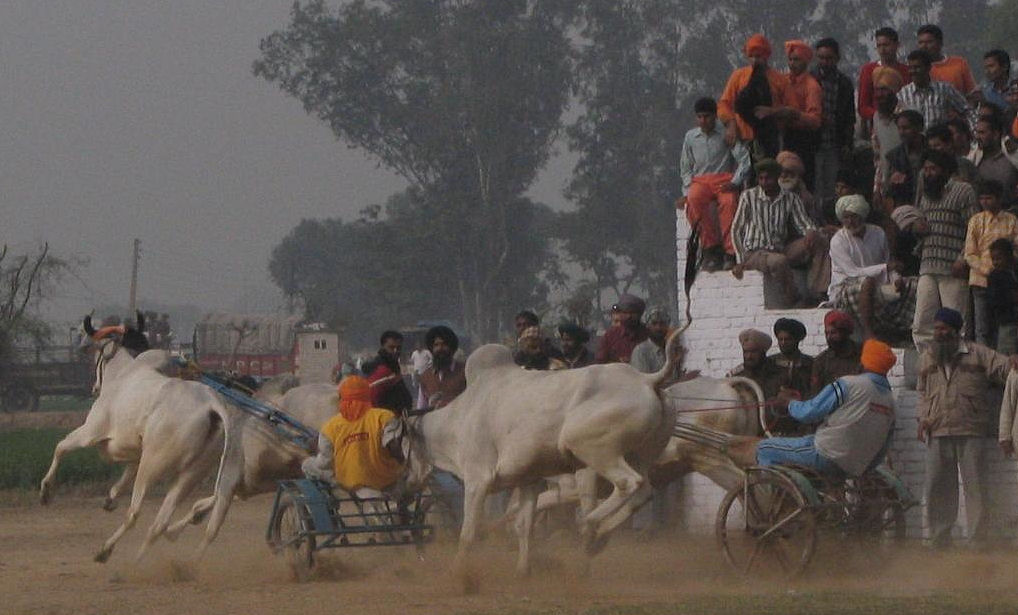
Abb.: पत्त्रे । Bullenrennen,
Qila Raipur - ਕ਼ਿਲਾ ਰਾਯਪੁਰ, Punjab
[Bildquelle: Torea Frey. --
http://www.flickr.com/photos/toreajade/380609928/. -- Zugriff am
2011-06-07. --
Creative
Commons Lizenz (Namensnennung, keine kommerzielle Nutzung, share alike)]
धारण - dhāraṇa n.: Träger
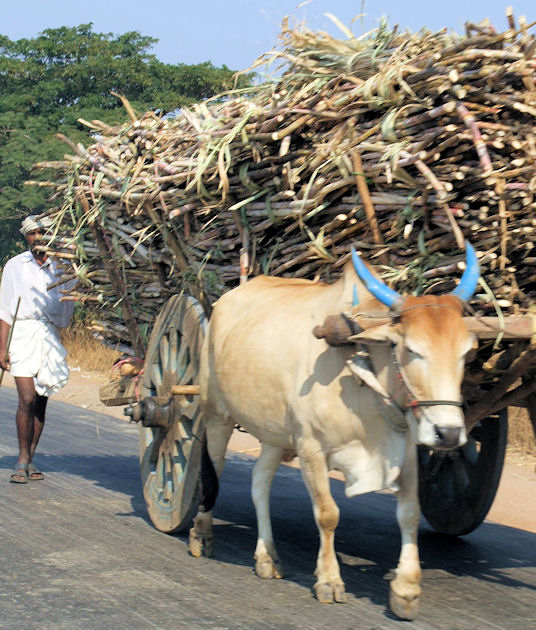
Abb.: धारणम् । Zuckerrohrtransport, Südindien
[Bildquelle: Poggis. --
http://www.flickr.com/photos/mspoggis/2205931404/. -- Zugriff am
2011-06-07. --
Creative
Commons Lizenz (Namensnennung, keine kommerzielle Nutzung, share alike)]
|
26c./d. paramparāvāhanaṃ yat tad vainītakam
astriyām परम्परावाहनं यत् तद् वैनीतकम् अस्त्रियाम् ॥२६ ख॥ Ein Beförderungsmittel, bei dem die Bewegungsmittel hintereinander ausgetauscht werden, heißt वैनीतक - vainītaka m., n.: "eine Sänfte u.s.w. mit abwechselnden Trägern" (PW) |
Colebrooke (1807): "A mediate one. As a porter carrying a litter, or a horse dragging a carriage."
वैनीतक - vainītaka m., n.: "eine Sänfte u.s.w. mit abwechselnden Trägern" (PW)
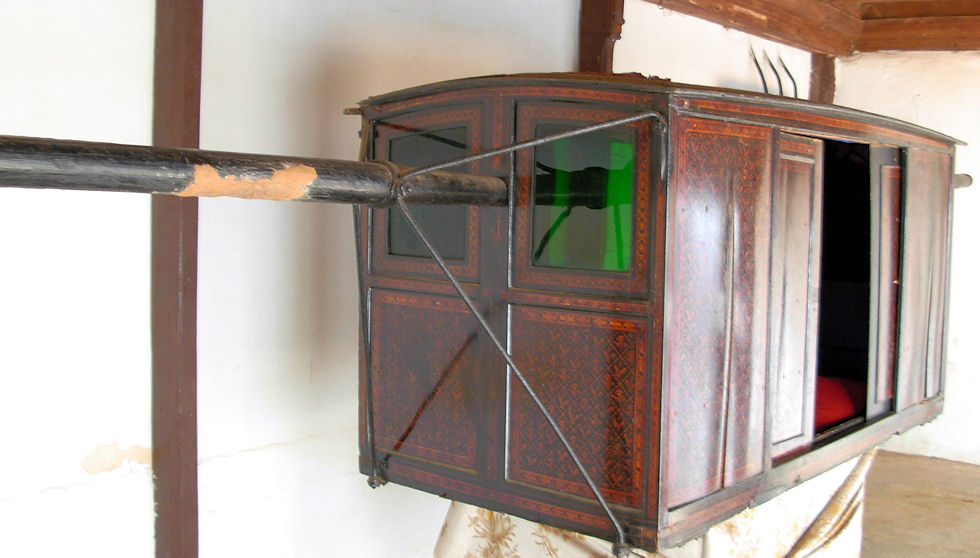
Abb.: वैनीतकम् । Sänfte, Kerala
[Bild: Noblevmy / Wikimedia. --
Creative
Commons Lizenz (Namensnennung)]
Zu kṣatriyavarga II. -- Vers 27 - 35 (Krieger I, Rüstung)